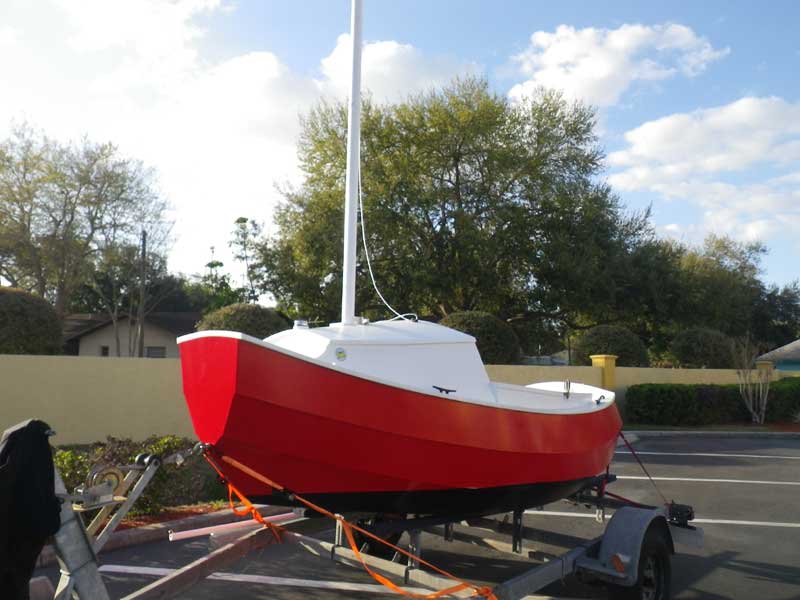
This was my first view of the SCAMP in the parking lot of a La Quinta in St Petersburg. She is a delightful little boat, ain’t she?
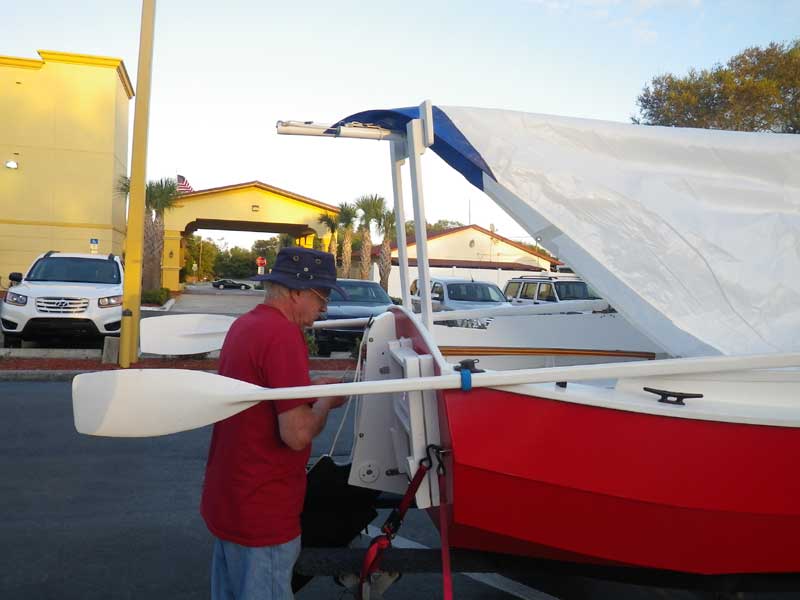
Mike and I set to work getting her final rigging done: Lash the sail to the spars, attach halyard, downhaul, and sheet, figure out the length of the lines, secure the oars, and a million other little details.
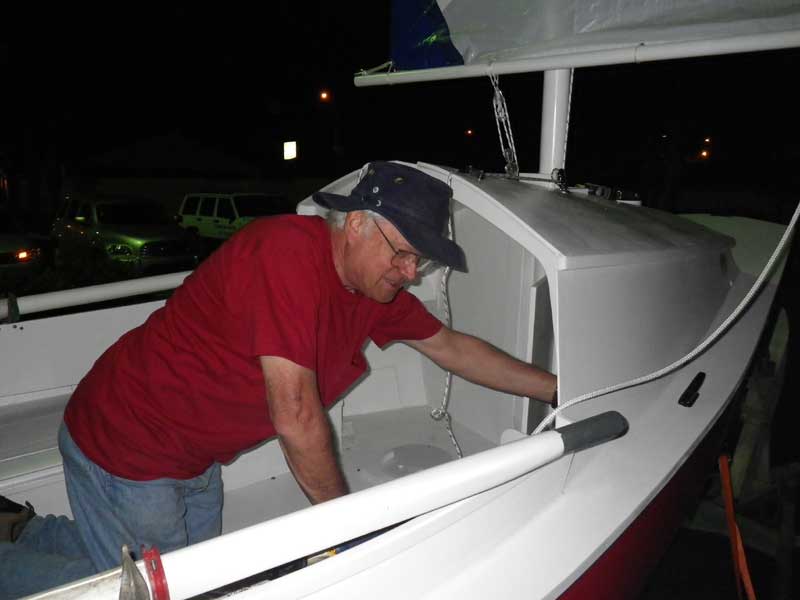
The fiddy bits are the bane of boat builders and sailors alike. Final layout went well into dark . . .
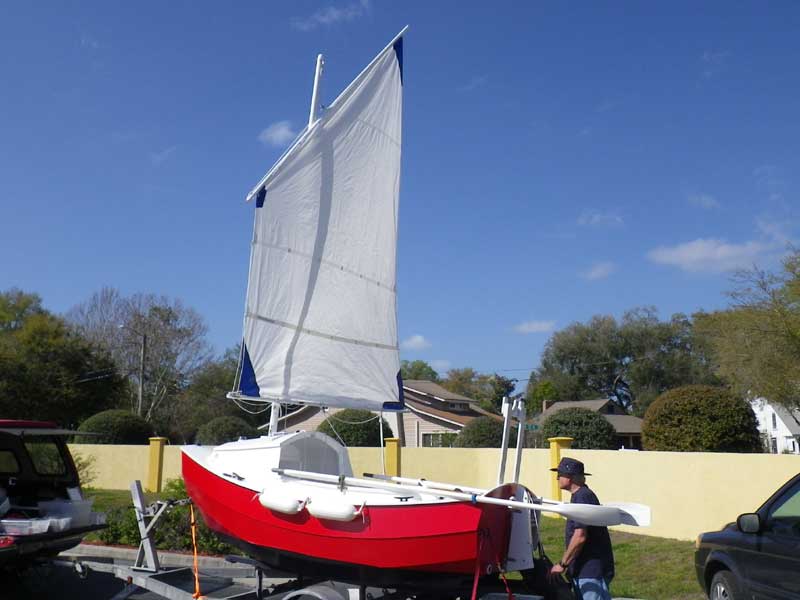
. . . until we finally had to stop and start again in the morning. This was March 4th, Safety Check day, so we had to hurry and get to the beach.
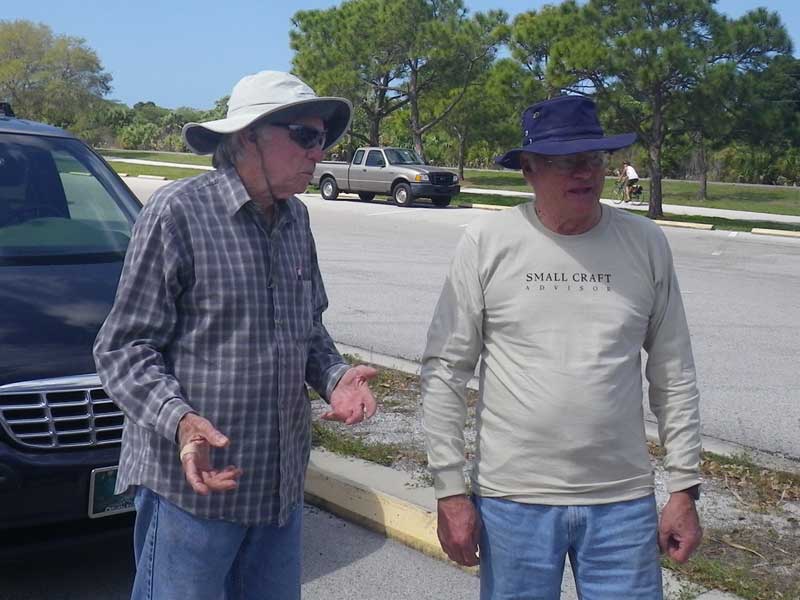
Once at Ft. De Soto State Park, we started meeting old friends, like John Wright, better known as St. John of Bastrop and also the namesake of the boat, the St. John.
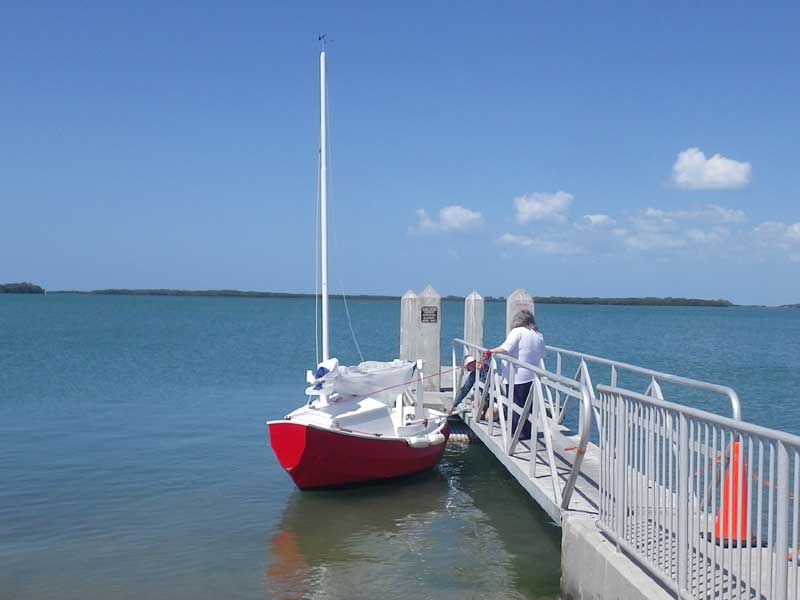
Ft. De Soto is roughly shaped like a V, with the launch beach at the point of the V. The public boat ramp in on the inside of the V, and we thought we might sail the St John around to the launch. She'd never been in the water before, so we needed to do a quick shakedown.
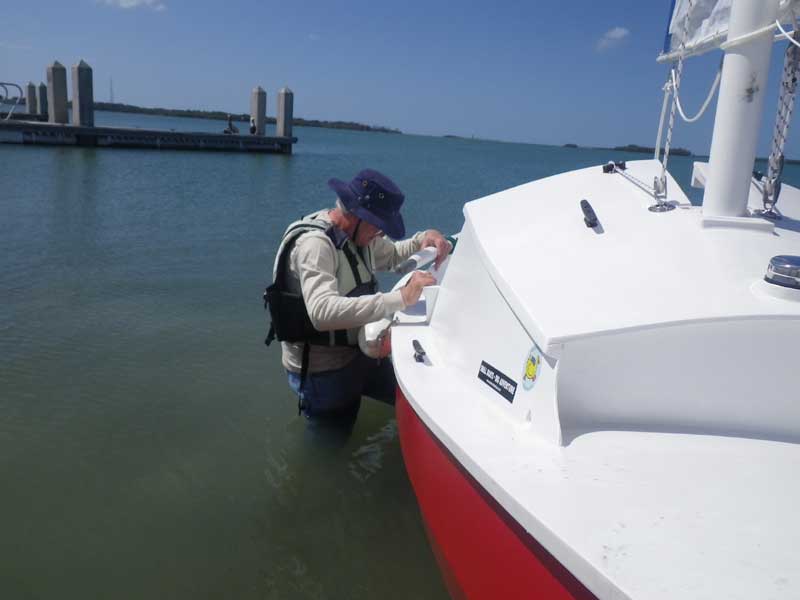
Right off the bat, we noticed the centerboard was sticking. The centerboard is very important for getting the boat to go to windward, so Mike did some quick alterations and we all was right with the world again.
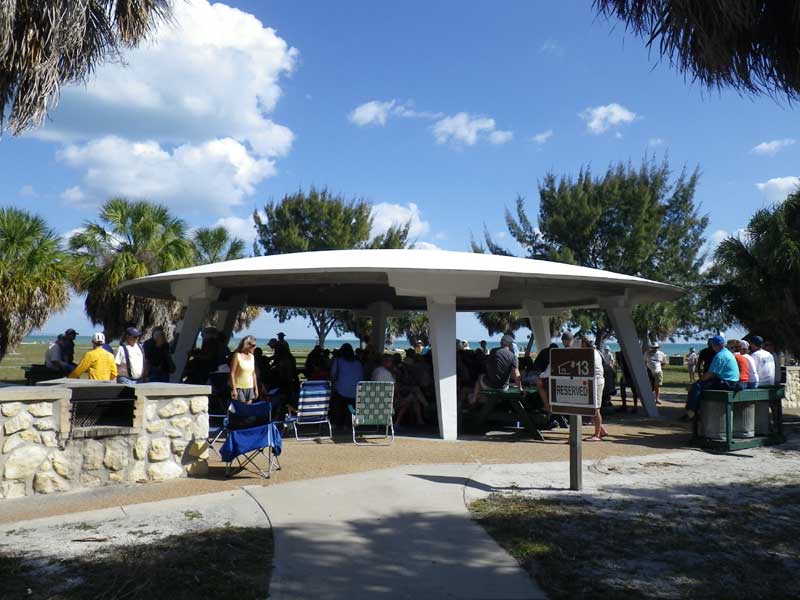
We had to stop our shakedown and go back to the launch point for the Captain’s Meeting, then go back to the public launch for a final check . . .
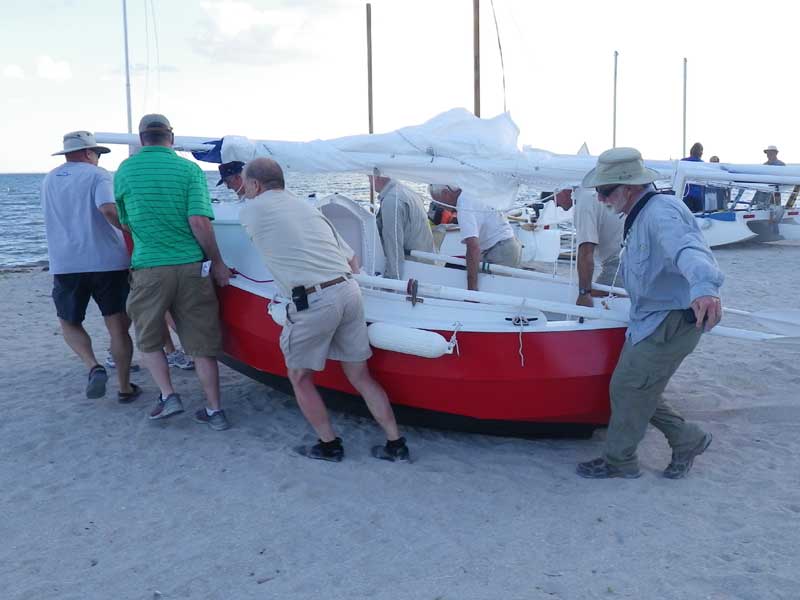
. . . then back to the launch beach to unload the boat (it was well into the afternoon: we decided it'd take to long to launch from the boat ramp and sail around to the launch beach.)
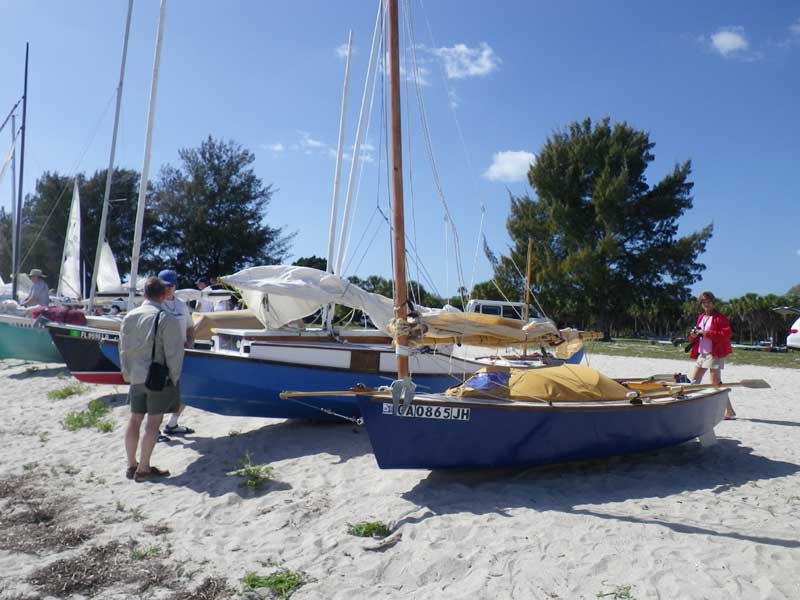
The launch beach is always an exciting bustle of frantic, last minute preparations. The boat in the foreground, the Little Gem, was as close to our boat in length and form as any in the event. She was captained by Scott Widmire, who had beaten me out of the Winner’s Circle in the 2006 Puddle Duck Racer World Championships (he got 3rd, I got 4th.) The next boat is Oracle, captained by Lugnut (Gary Blakenship – 6 time veteran of the EC) and crewed by Scott Gosnell (Scott was supposed to provide a boat and captain for Mike on this year’s EC, but had an injury. He recovered and signed on as crew with Gary.)
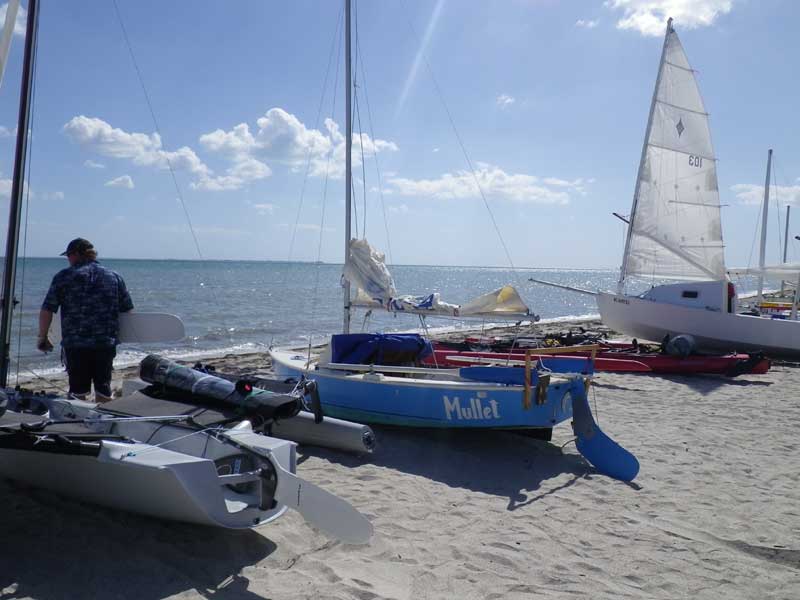
Mullet is a favorite boat of mine, a small 16 footer that has been a veteran of many ECs in the past.
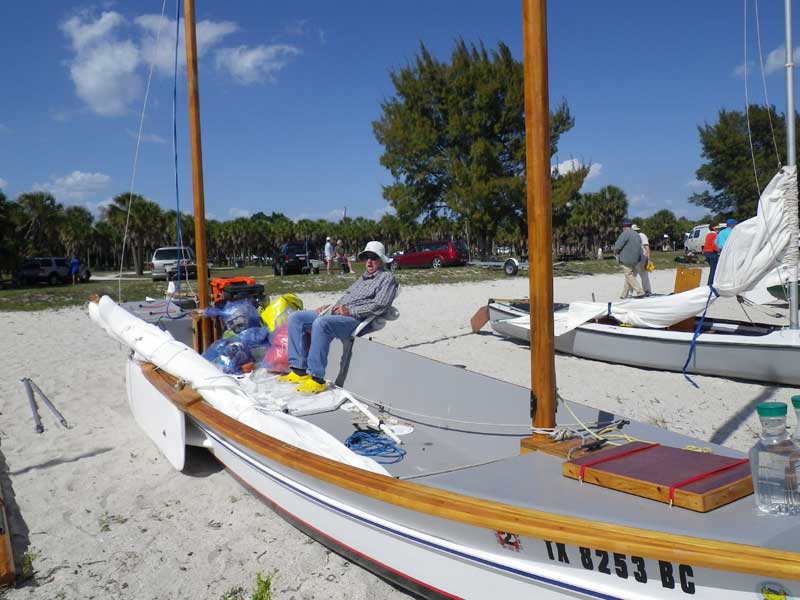
St. John of Bastrop in his modified Laguna. If you remember, Mike and I did the EC in a Laguna last year.
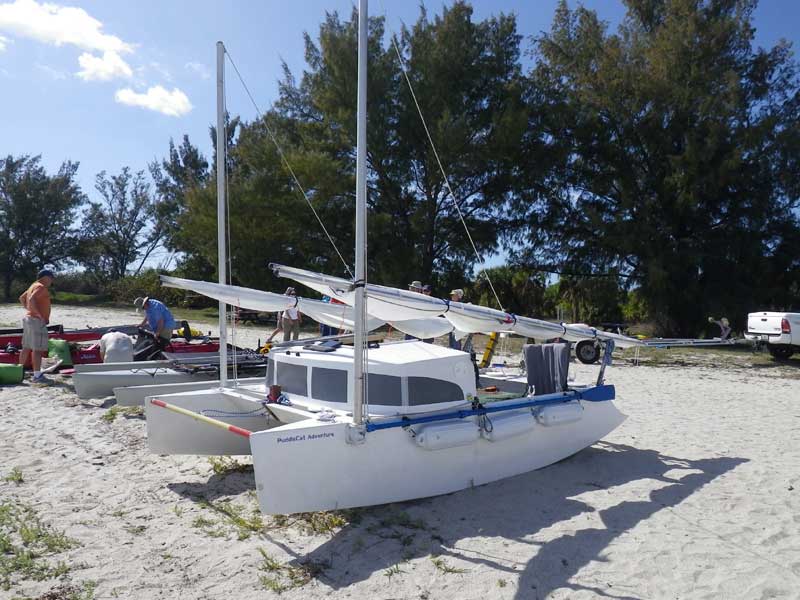
Every EC has some radical new designs. This is the only PuddleCat known to exist. Notice the bi-plane rig. Pretty cool and pretty ambitious. There were also two guys on stand-up sailing boards. Again, very ambitious.
. 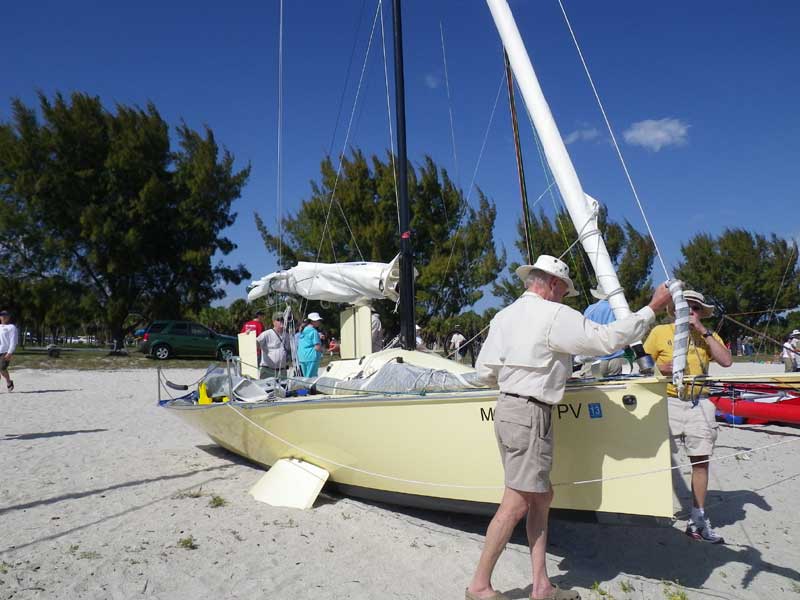
Meade Gougean of System 3 epoxy had brought a radical design last year. This year, he was in a sailing rocket i550 called Hot Canary.
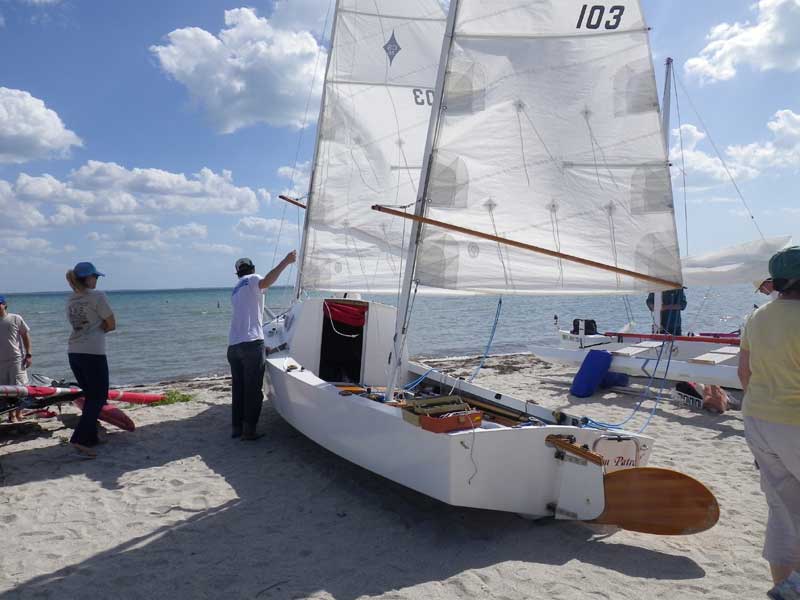
This is a Core Sound 20 – a fantastic expedition boat – with a cuddy cabin on it (to each their own, I guess.) The Dawn Patrol, captained by DancesWithSandyBottom and crewed by SOS (Paul and Alan Stewart.)
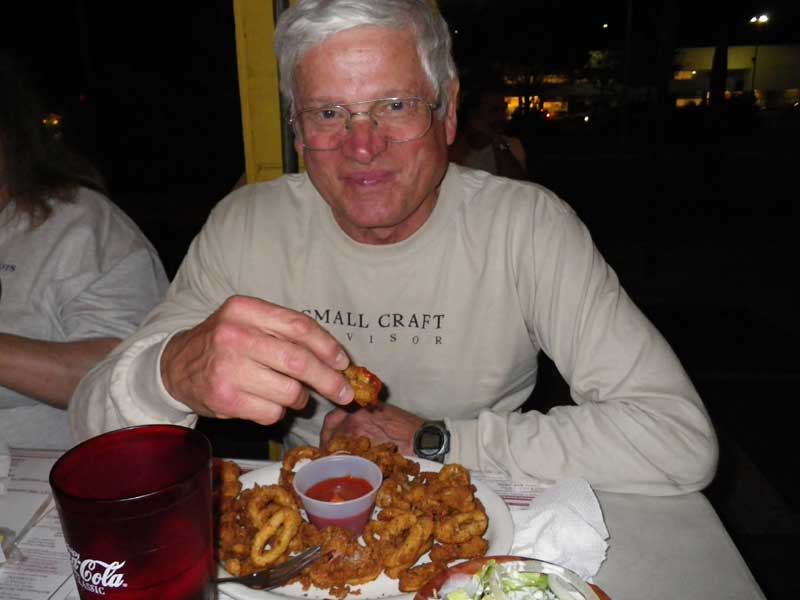
One last dinner (at the Casual Clam, very good and very reasonably priced) and then back to the hotel for a final night of sleeping on a mattress.
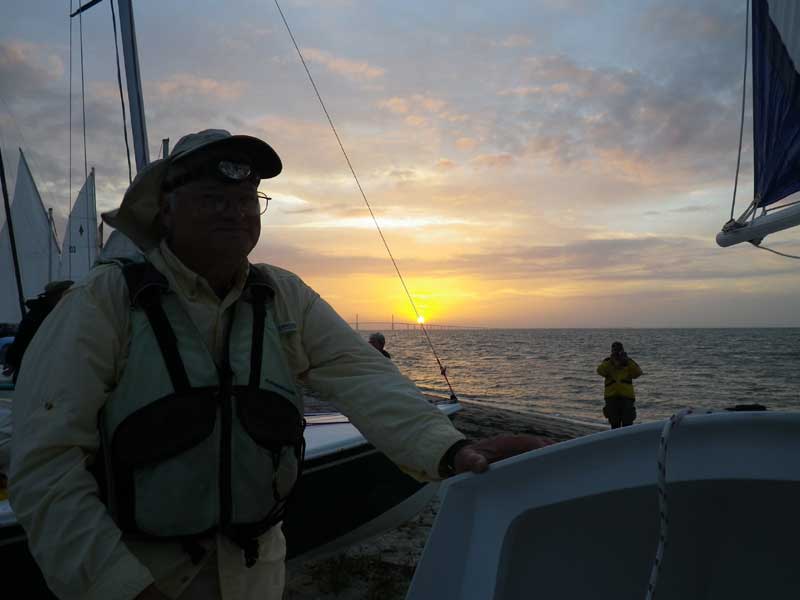
Dawn came early enough, that’s for sure. At 7:00am, the starting horn sounded and we were off.
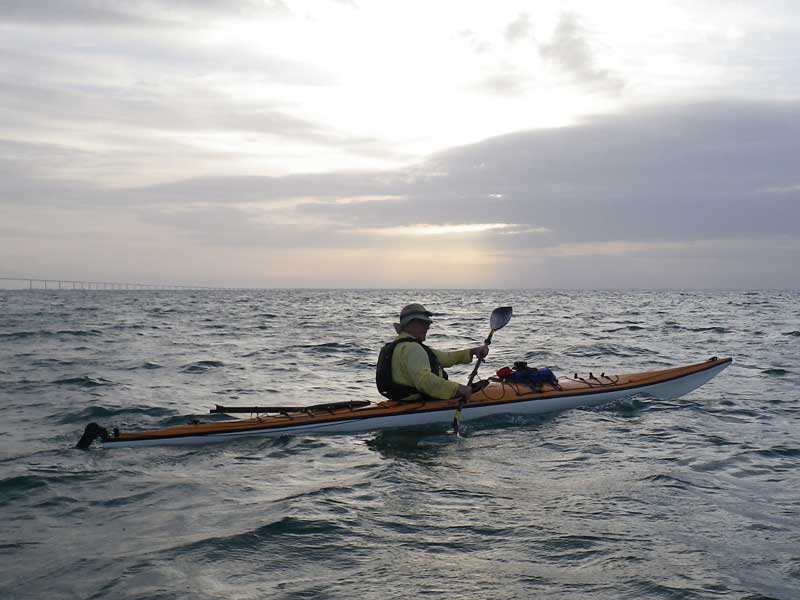
The initial beach launch is kind of a scrum with kayaks and sailboats all trying to get to the water (sailboats give way to paddlers.) Our launch, facilitated by 5” fenders, went as flawlessly on the SCAMP as it had gone on the Laguna the year before: Stick the fenders under the skegs and push. The boat rolls down almost effortlessly.
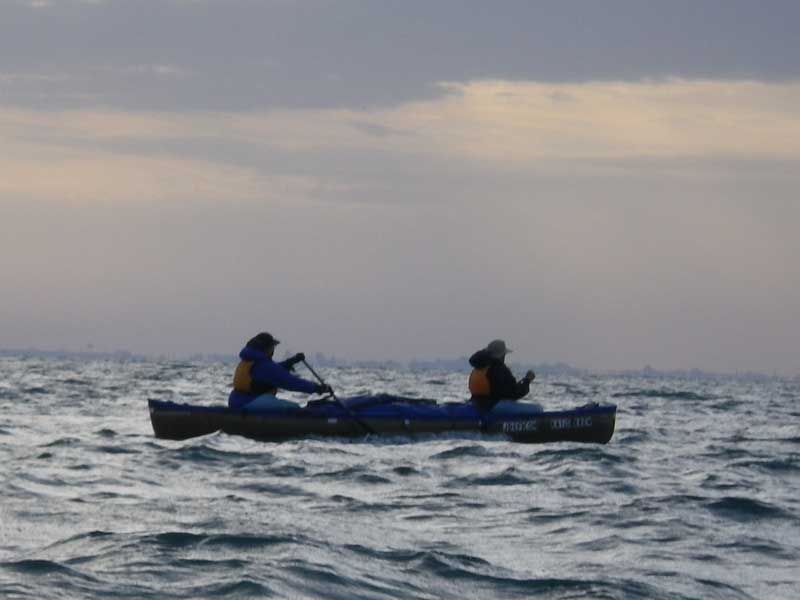
Troutheart and Paddle Trader in their Bell canoe. I’m not sure, but I think this might be the only canoe in the race.
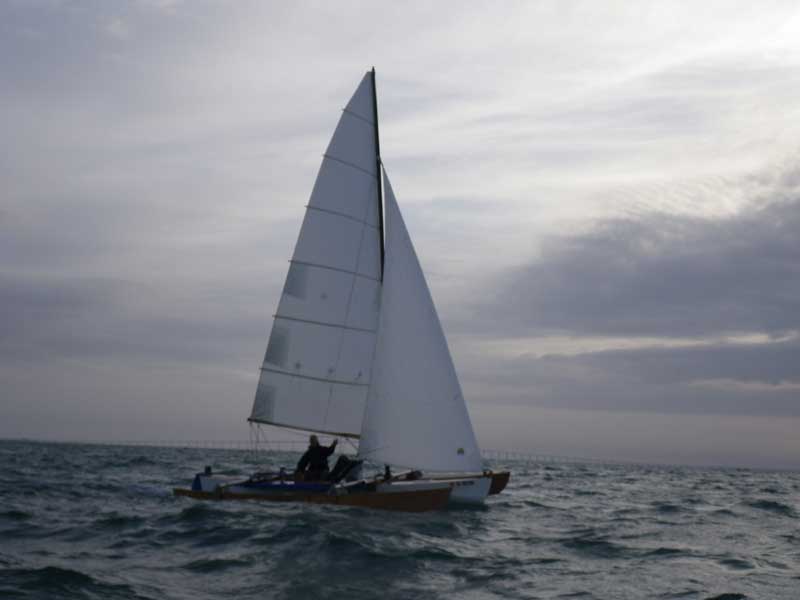
Iszatarock (Hal Link) in his fantastic Tridarka Raider.
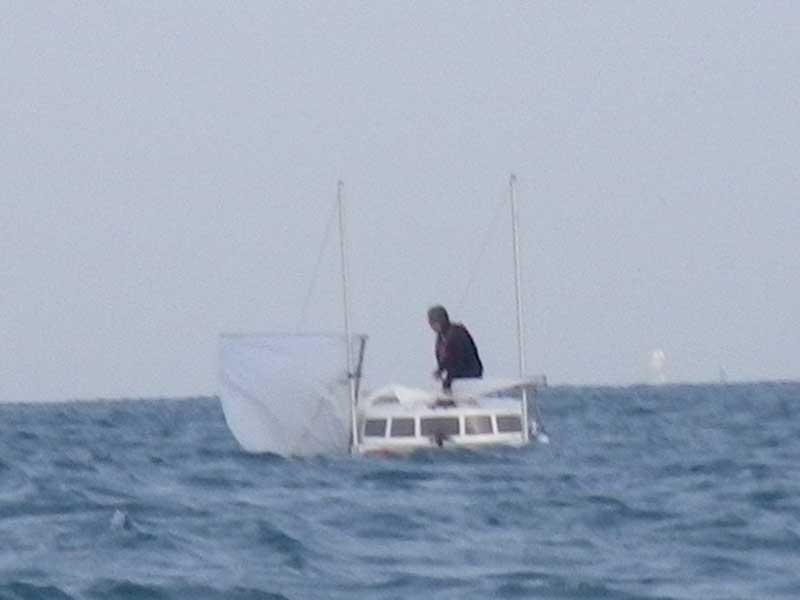
Right off the beach, some peopel were having problems. Roger Mann in his PuddleCat had to drop and raise sail a couple times - then we never saw him again.
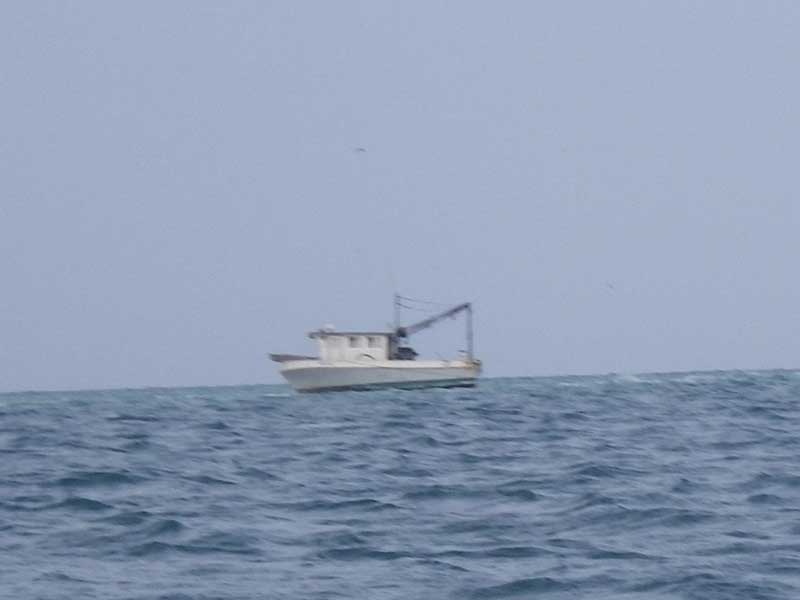
The wind was from the south to south east (right in our teeth) so we decided to “go outside” – run down the Gulf where we had some room to tack instead of trtying to fight our way against the wind in the narrow confines of the Intercoastal Waterway.
In a harbinger of things to come, as we exited Tampa Bay around Anna Maria Island, I saw this boat (a commercial shrimper?) high and dry on the shallows around Passage Key.
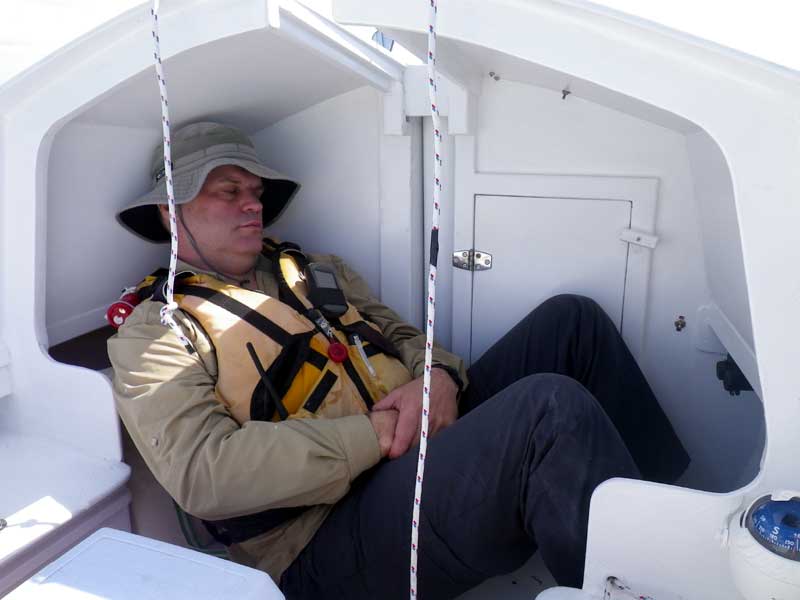
It was shaping up to be a long day. The winds were in the mid to high teens and right on our nose. We had to make long tacks for every foot of forward progress. I decided to try napping in the SCAMP’s “veranda” a unique covered area that offers protection from the sun.
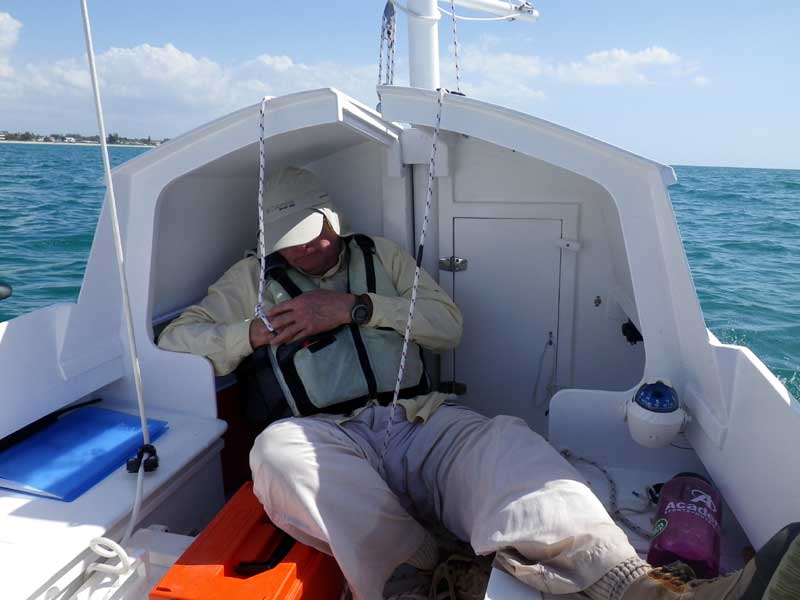
It worked pretty well, so Mike gave it a try, too. Sleeping while sitting up is not all that comfortable, though.
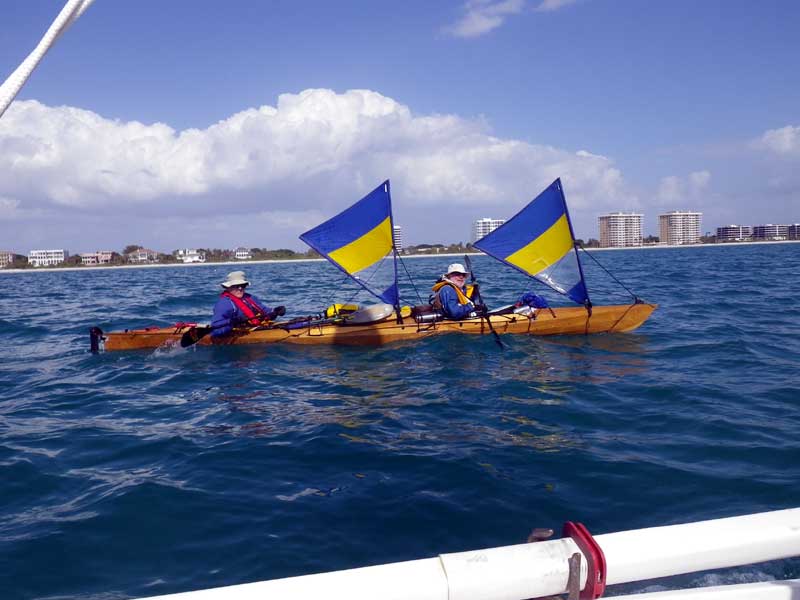
The day wore on and on with us making little headway. The boat was performing wonderfully: pointing well into the wind and keeping us nice and dry, it is just difficult to sail directly into the wind and waves. It didn’t take long for Savannah Dan and Paddle Maker to catch . . .
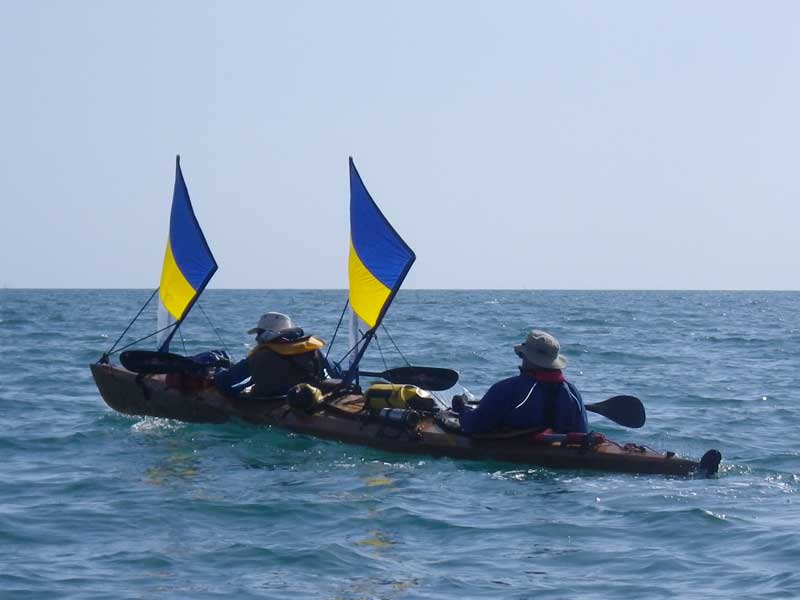
. . . then pass us. We ran in to these two last year much later on the first day – down by Venice. This year, it was way up by New Pass. I was starting to get frustrated by our lack of progress.
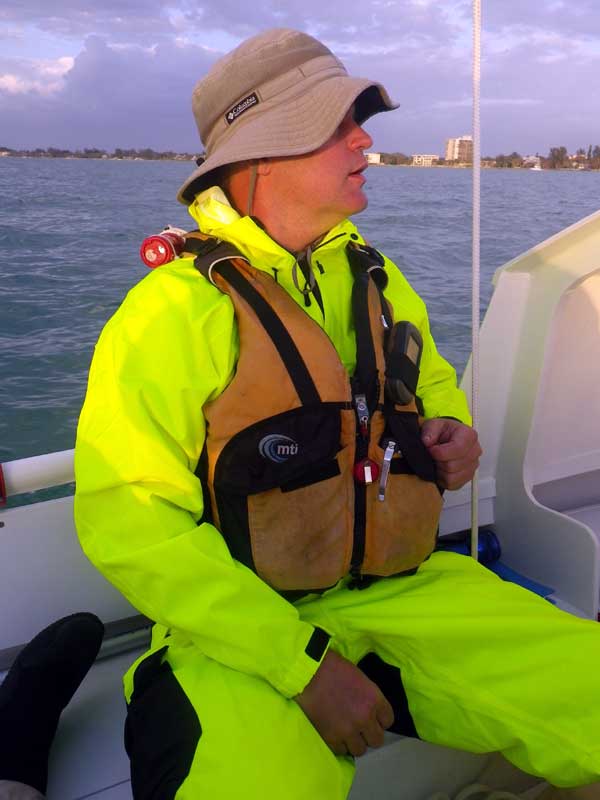
Day turns to evening and the temperatures drop from the 70s to the 50s. This combination of high quality rain gear (cuts the wind) over a jacket and thermal pants was my night-time uniform. Why so bright? If I go over at night, I want someone to be able to see me. This stuff ain’t fer fashion, you know.
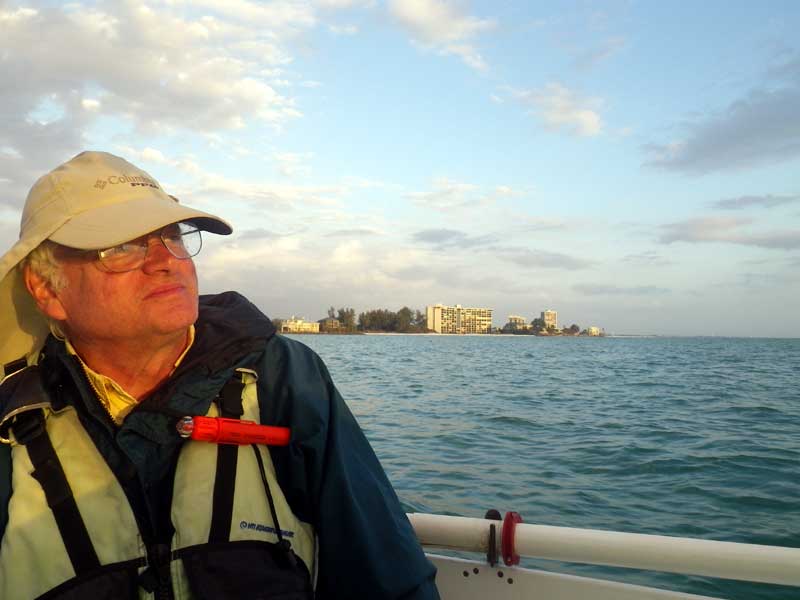
It had taken us all friggin day to battle our way down to Big Sarasota Pass, and things weren’t boding well for the evening, either. Mike and I decided to establish 2-hour watches for night hours, the off watch sleeping on the leeward seat when the wind wasn’t heeling the boat over too far.
All night long: Tack out, tack back, Tack out, tack back. It was maddening.
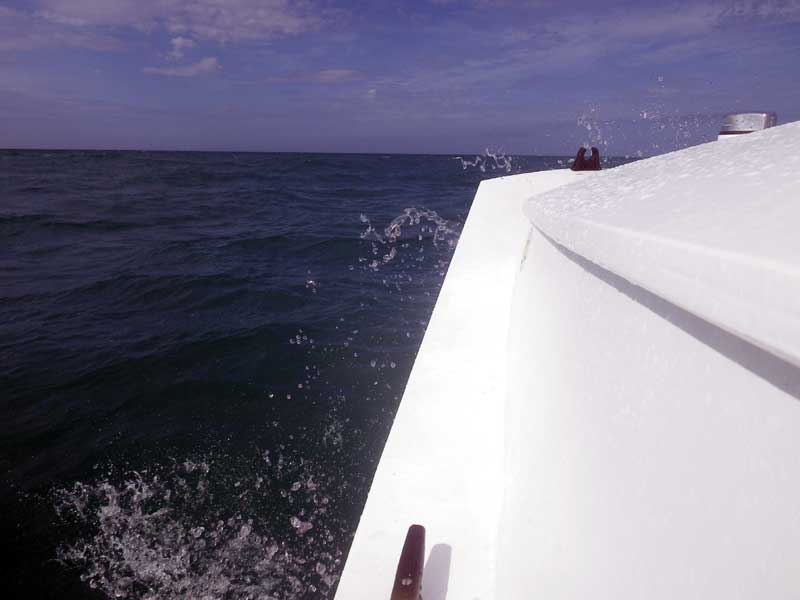
Morning found us barely any further along the beach than we had been the night before. The wind was still against us and the waves still pounded us on the forward quarter. At least the SCAMP is a very dry boat – we hardly took any spray at all.
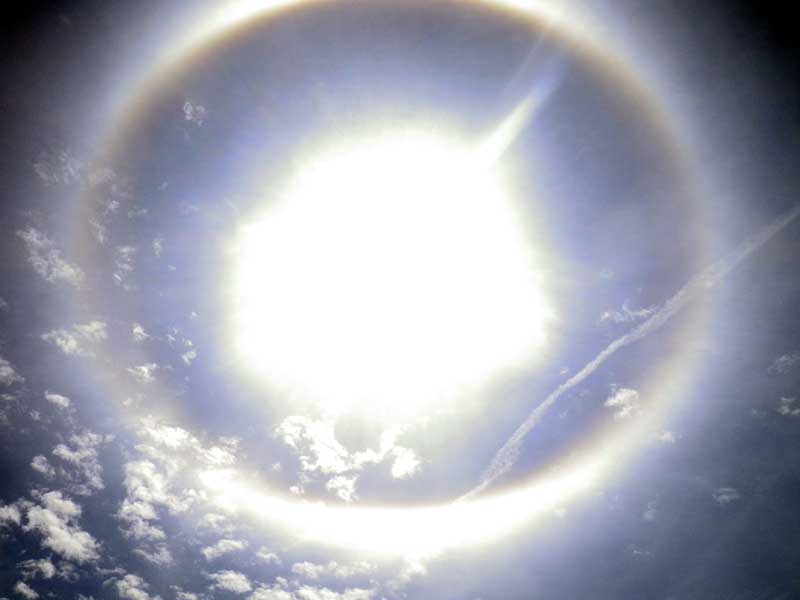
Florida has an environment and ecology that boggles my Oregon-born brain. A rainbow around the sun? Who ever heard of such a thing?
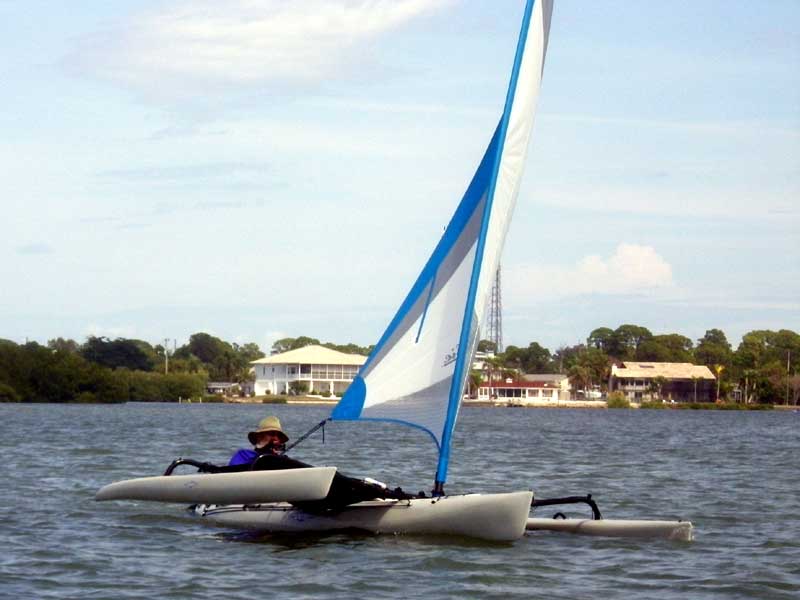
We'd been running ‘outside’ – offshore of the barrier islands – to have some sea room for maneuvering. As we approached Check Point 1, we needed to choose a pass in which to enter the Intercoastal Waterway and Charlotte Harbor. We'd sailed by all but the last two passes: Stump and Gasparilla. We'd been warned that Stump Pass was blocked by dredging, but it looked clear to us, so we dove in there.
Once inside, we met Bosab (Charlie Fast) in his Adventure Island Tandem.
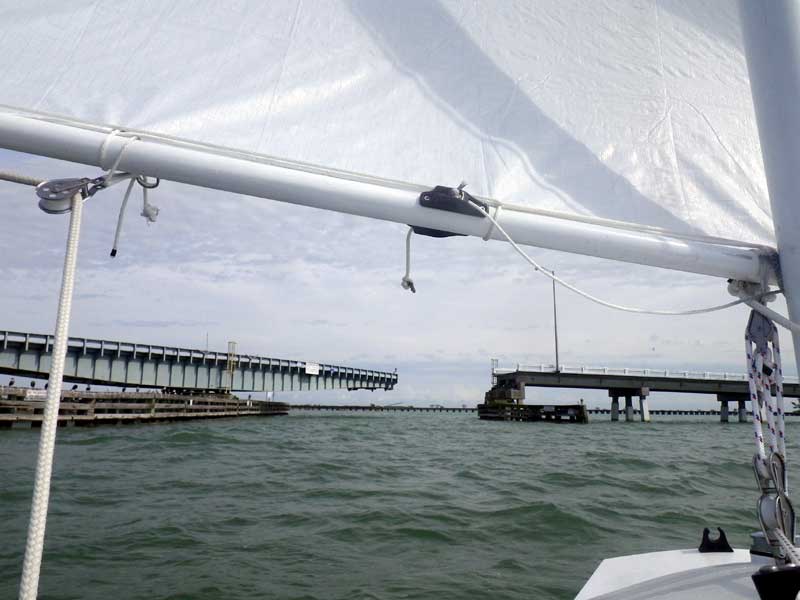
Bosab joined us for the sail through the Boca Grande swing bridge. Last year, we came to the bridge at night, goobered the approach, and had to drop our sails/masts and skim under the bridge using the sweeps.
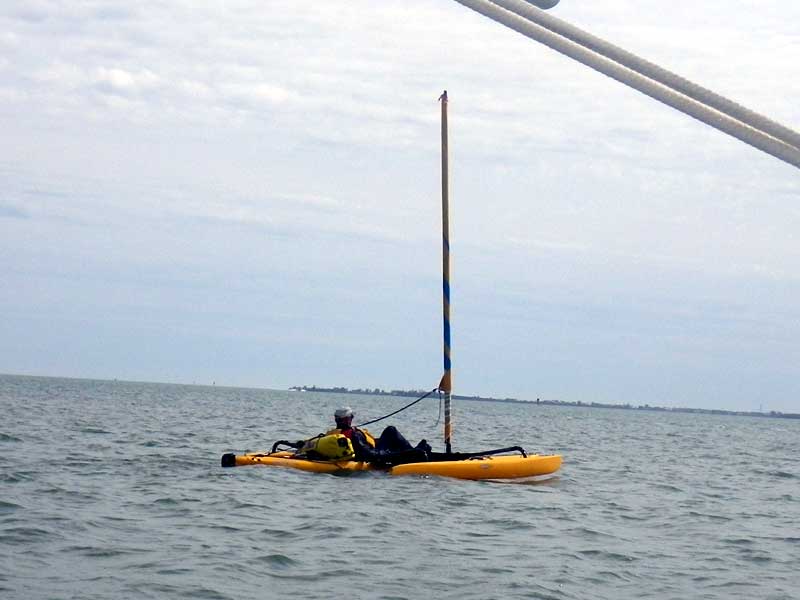
Once under the bridge, Bosab gave us the “Follow Me!” gesture and nearly got us lost in the twists that lead to Check Point 1. Fortunately, we saw Brogan (Paul Myers) in a yellow Adventure Island. Brogan pointed us in the right direction and we corrected our course.
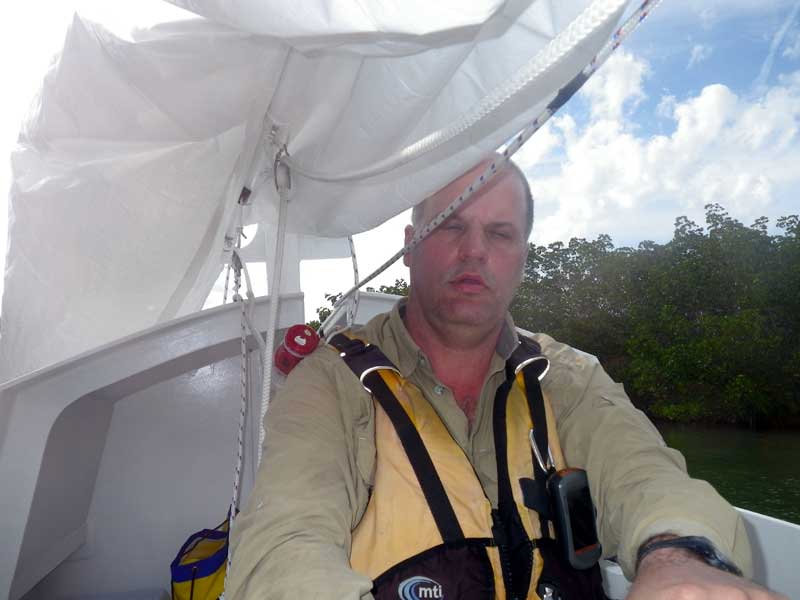
There is a fixed bridge just before Check Point 1 that requires anyone with a mast higher than about eight feet to drop sail/mast and row in. Mike had made some really clever boom gallows for the SCAMP that allowed me to row unhindered. Why I look all grunty here, I don’t know.
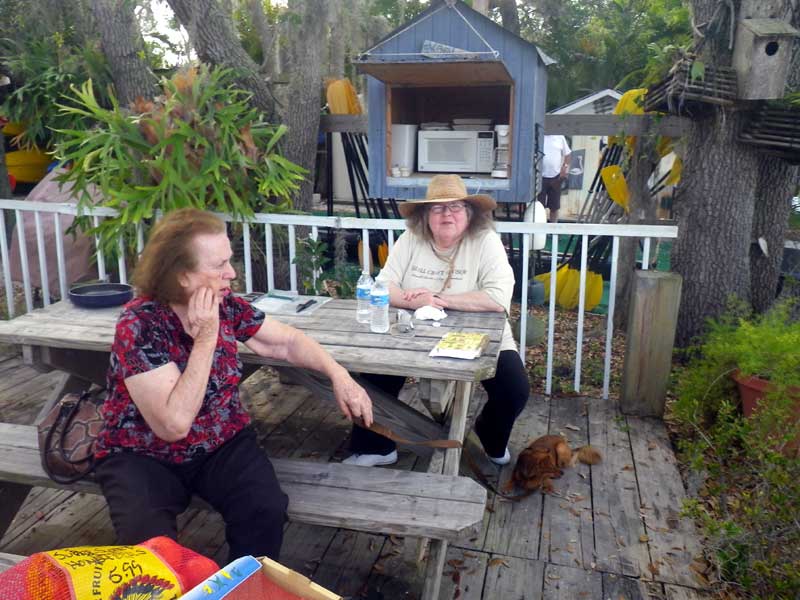
Once at Check Point 1, we took a much needed break with our shore crew, Mike’s wife Jackie in the background (with faithful adventure hound, Dickens) and her mother, Pauline.
Our official time for reaching Check Point 1 was 24 hours, 54 minutes, but I don’t see how that is possible. We started at 7am on the 5th and didn’t reach CP1 until mid afternoon (3pm or so) on the 6th.
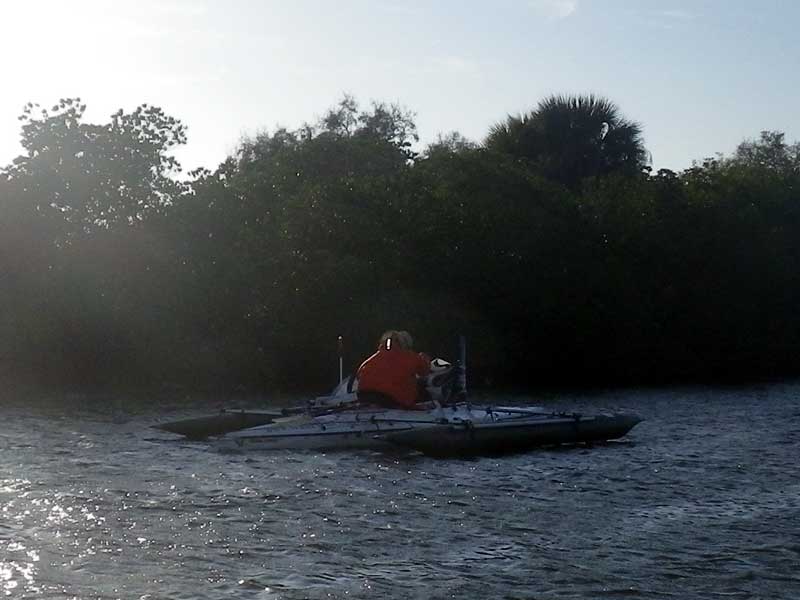
As evening came on, Mike and I set out again, passing Chief (Steve Isaac) on the way out. The wind was picking up – as you can tell by the surface of the water in this protected area.
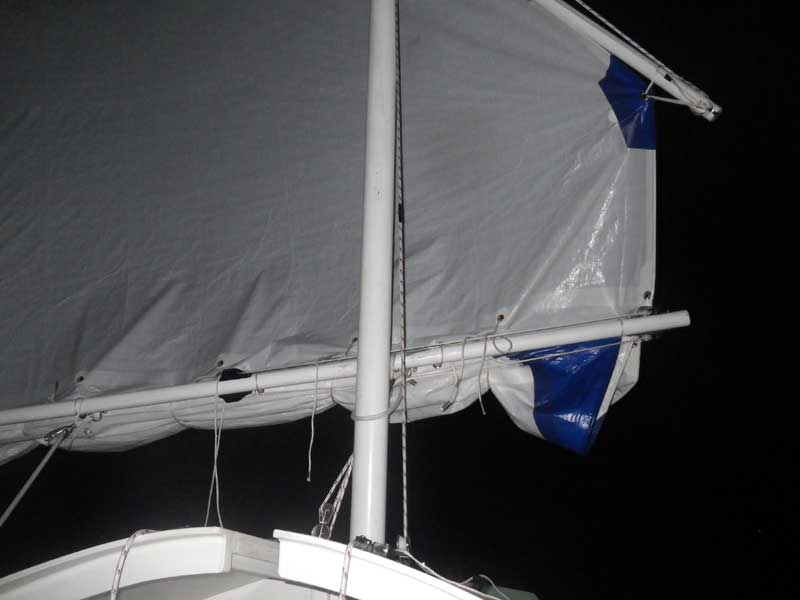
Once out in Charlotte Harbor, the water was quite lumpy and the wind was in the mid teens. Mike readily agreed to one reef, but took some convincing to put in the second, accusing me of “being just like to merchant captains in the Hornblower novels: Always reefing at night.”
I dunno about Oklahoma sailing, but in Oregon, we learn to reef early and reef often. My whining finally got to him and we hove to, put in the second reef, and continued.
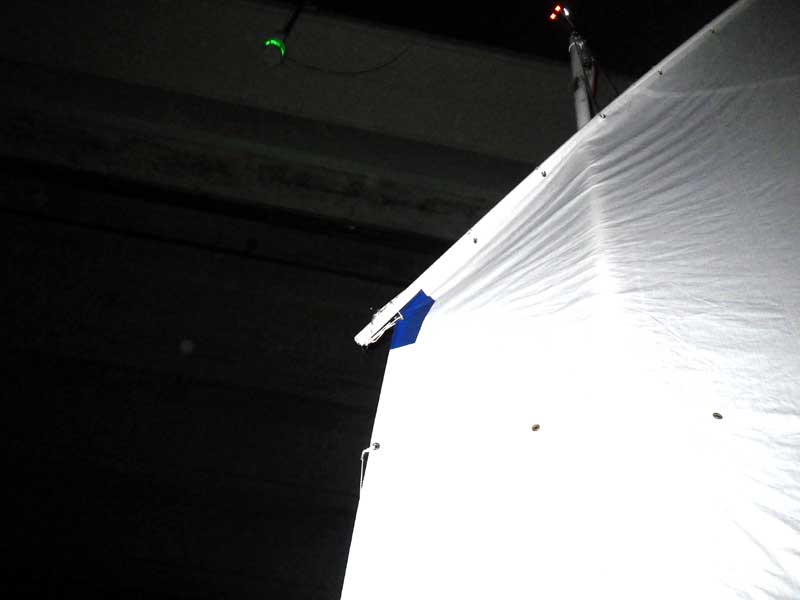
We stayed inside the Pine Island Sound all night as it was more protected from the wind and waves than the Gulf would have been. The charts showed the Sound as usually having a foot or more of water in it – even in the shallow spots, so I pretty much ignored the channel markers and did “straight line” navigation. As you might expect, we ran hard aground and it took us quite a bit of time to free ourselves.
It was still very early in the morning when we finally reached the lights of Point Ybel and were able to pass under the bridge and back out into the Gulf. This is a very bad picture, but I am trying to show that even though I knew the bridge is 23ft high, I was still worried about our 17ft mast.
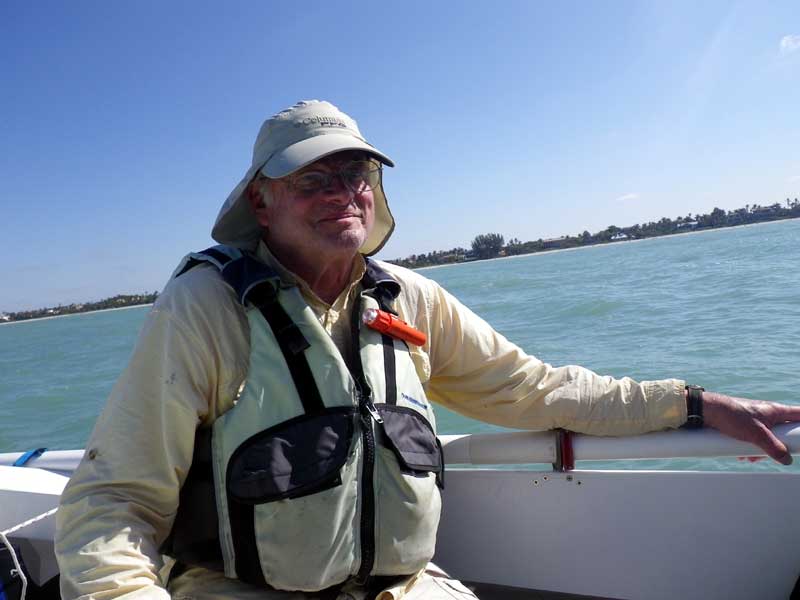
Mid morning had us in good spirits off of the pier at Naples, watching the Gulf Stream jets zoom iun and out of the airport while we were still beating into the wind.
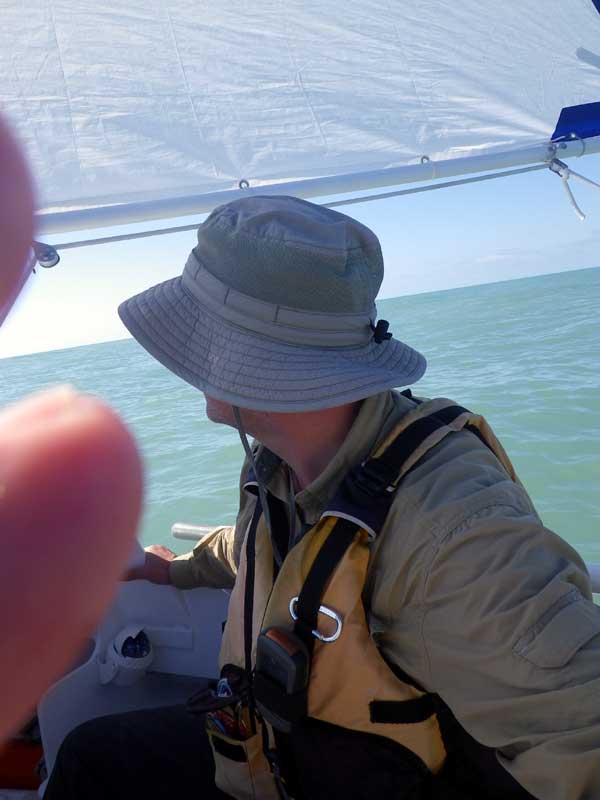
Mike, I love ya like a brother, but iff’n ya can’t keep yer mitts outta the pic, ya can’t take no mo pictures (which he was fine with)
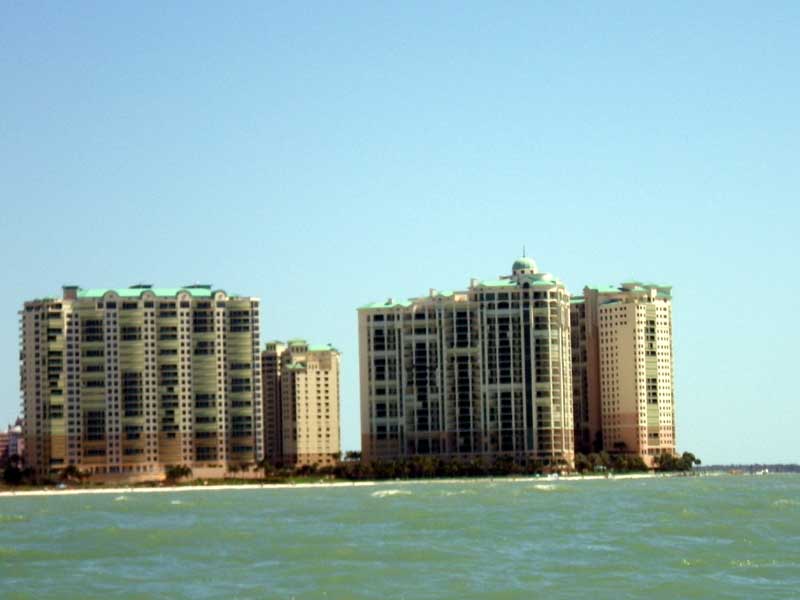
This is another thing you won’t see in Oregon. Our ocean is angry and actively seeks to destroy the pitiful efforts of Man. “Pacific” my eye.
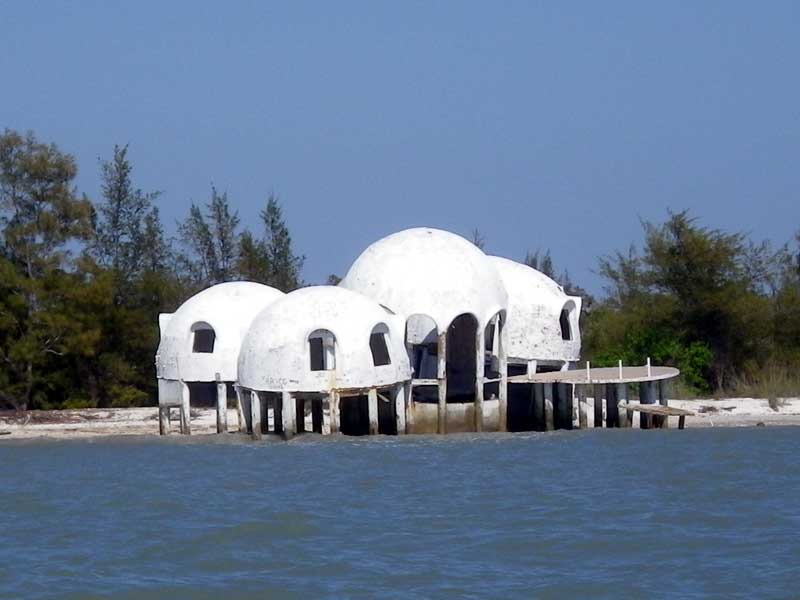
As we rounded Cape Romano, we came across this . . . what? A set for a sci-fi movie? Actually, this is the Dome Home, which Hurricane Wilma kicked in the teeth. The family that owns them wants to restore them, but they are in a protected area and the red tape is holding up any restoration efforts.
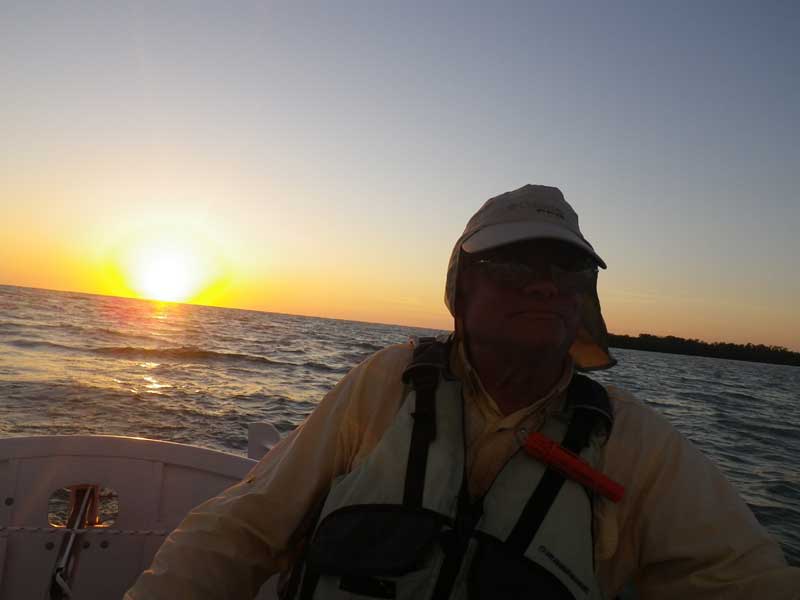
Sunset saw us just outside of Indian Key Pass – our route to Chokoloskee, aka Check Point 2. The wind was dying and we were right at the end of the rising tide, so I broke out the sweeps again and started rowing. I kept it up until I could no longer fight the tide, so we pulled over to the side, dropped the hook, and secured until the tide shifted again – ramming an Osprey nest with our mast in the process. You have no idea how unnerving it is to try and catch a couple hours sleep with a pissed off Osprey angrily peep-peeping at you.)
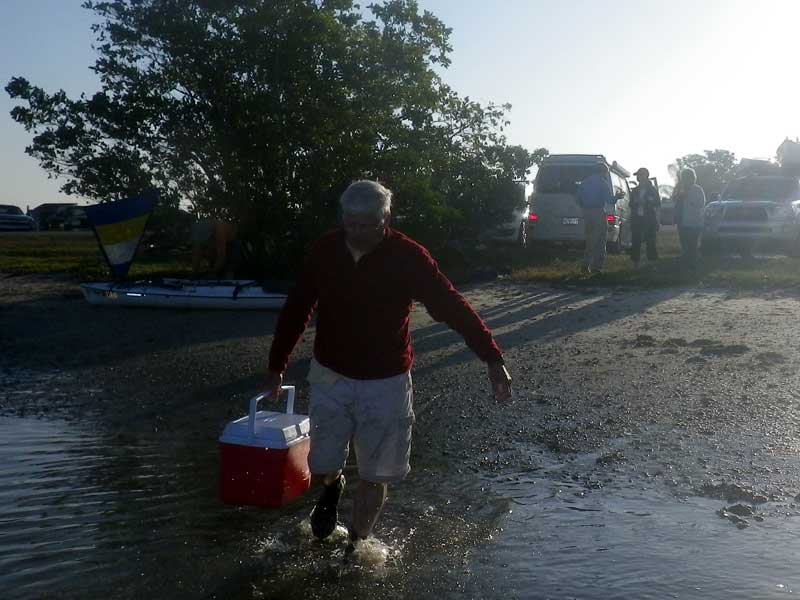
The tide changed at 11pm and we'd rowed through Indian Key Pass by ~1am, then sailed across the very shallow bay, arriving at Chokoloskee at about 3am. I was very discouraged and near mutinous, so Mike tried to find a hotel with a soft bed and showers to bolster my spirits, but none were open. We finally just crashed in the boat. At ~7:30, I woke up and said “We have to leave now if we are going to make it out before the tide changes and we are stuck here until 6pm.” Mike agreed, refreshed his ice from the nearby store, and off we went.
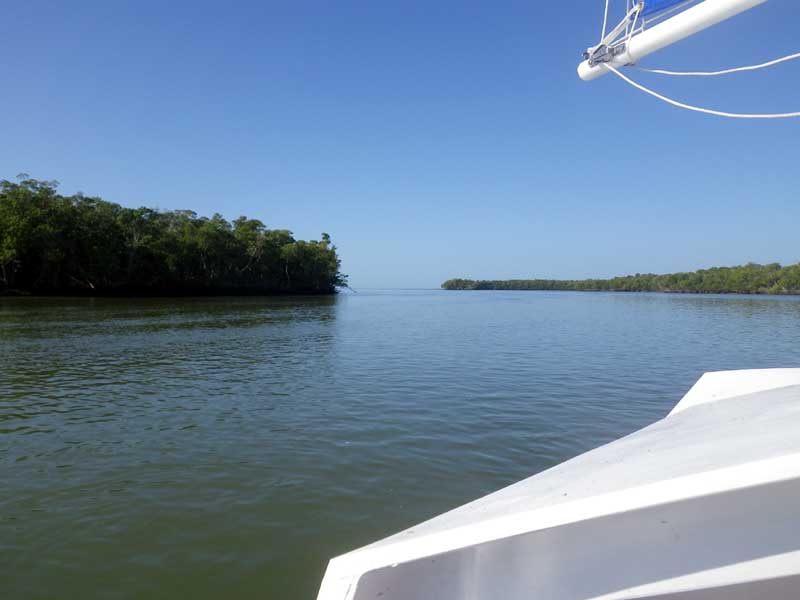
Mullet had followed us in the night before and had immediately left again, saying he was going out Rabbit Key Pass. I hadn’t plotted that pass, so we followed Chokoloskee Pass. I had nine waypoints marked and we hit every one. We had a perfect exit from Check Point 2 and were well on our way to Flamingo.
The only thing that marred our exit was an osprey that hovered some 40 feet above us, angrily 'peep peep'-ing at us. Do osprey remeber? Do they bear a grudge? Without a better understanding of raptor psychology, all I could do is cover my eyes and wait until he flew away.
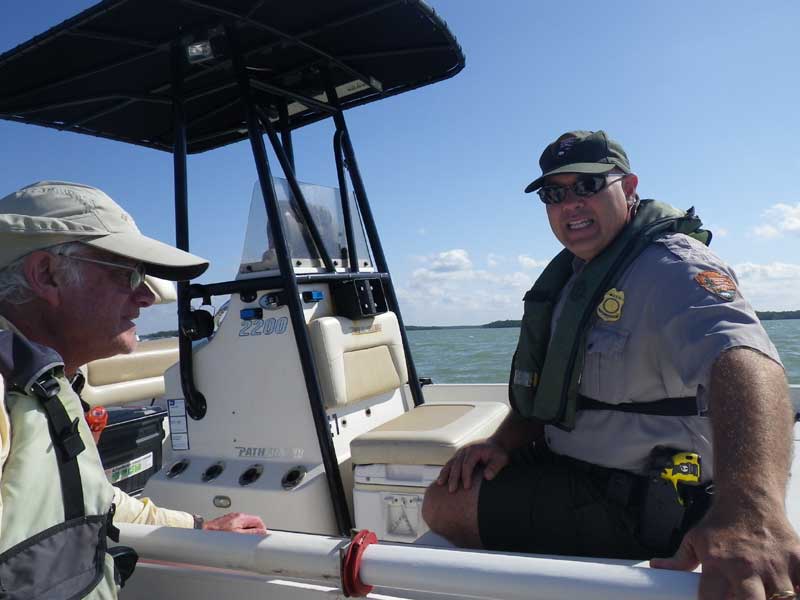
Just minutes after reaching the open ocean, we were stopped by a park ranger. He quizzed us as to where we were going and what safety gear we had (he didn’t cite us for having only 2 flares instead of the required 3.) I let slip that we were part of a group participating in a race and he got ALL interested after that. He asked if there was a website, I admitted there was, and he roared off at top speed.
The joke was on him, though – the website was down due to technical issues. Still, I feel bad about my faux pas, I thought I was more sly than that.
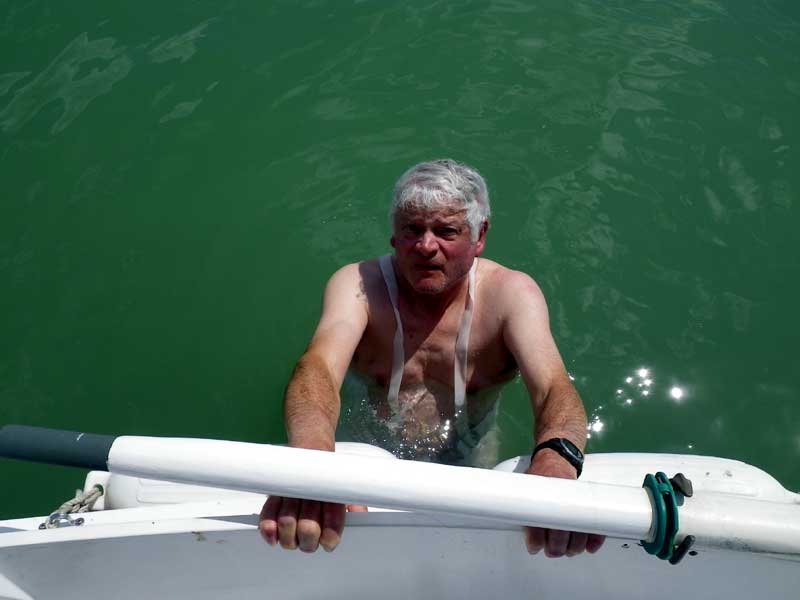
The incident with the “grouper trooper” seemed to cast a pall on this leg of the race. Moments after he left, the wind died completely. Mike took the opportunity to harness up and go over the side to check on the centerboard. Everything was functioning as expected, so we just spent the day “bobbing and baking.”
As the afternoon wore on, the weather worsened and thunder clouds started to form.
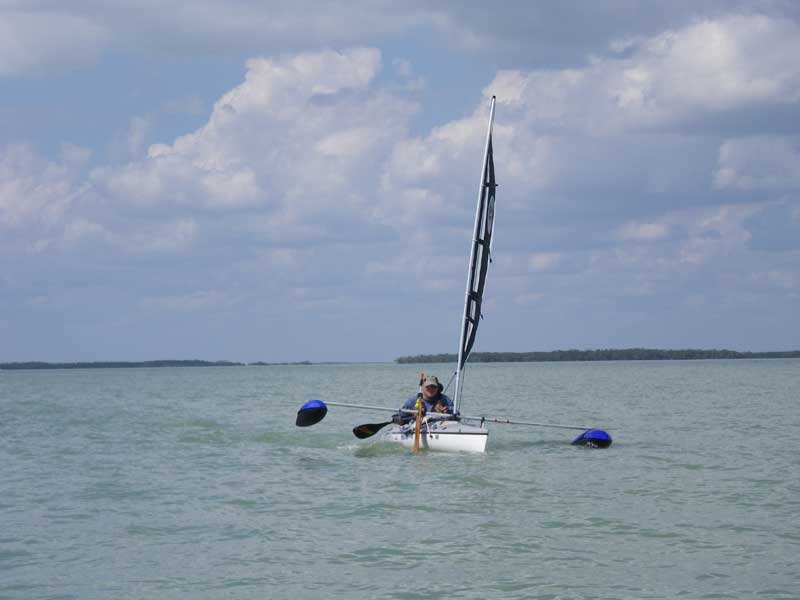
In the distance behind us, I saw a tiny dot resolve itself into a sailing canoe captained by Whale (Bill Whale.) I watched as he continuously paddled from 3 miles behind us until he came along side, said “Hello” and kept paddling until he disappeared into the clouds and mist some 2 miles ahead of us. I was in awe – I’ve never kept paddling so far and so long in my life, the man was like a machine.
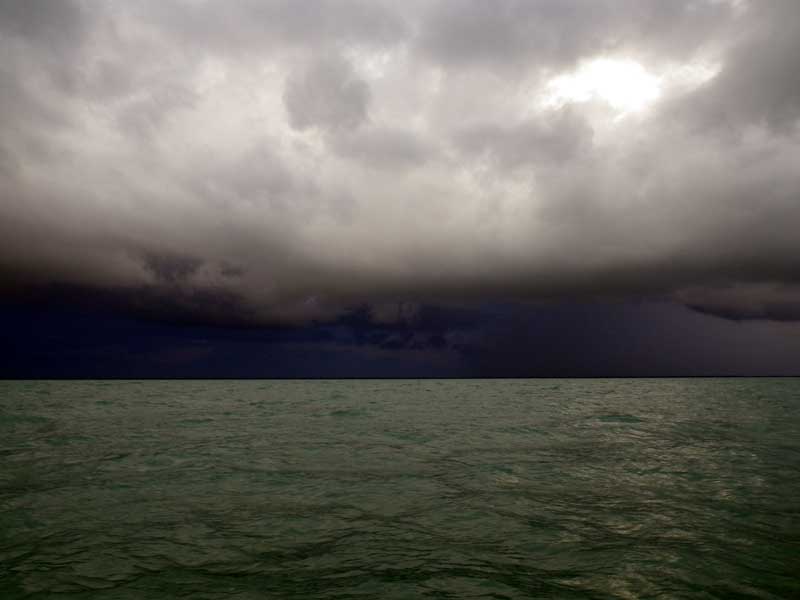
This is where we were heading – and there was lots of wind under those clouds. We reefed once just after dark. Mike took first watch while I tried to sleep. It was rough and ugly out there. I took my watch and fought the tiller the whole time – the wind was dead on our nose and the waves were just random, malevolent lumps of water, existing for no other purpose than to slam into us.
Finally I had had enough. I asked Mike to help me reef and in the process, we got tangled, the wind caught the sail, and the boat gybed violently. Both Mike and I were tossed to the bottom of the boat and she started heeling over. I was certain we were going to dump. Mike yelled “Sheet! Sheet!” and as I heard water start coming over the side, I popped the mainsheet, released the pressure on the sail, and we popped back up.
We'd shipped maybe a quart or two of water over the gunnels, but I was badly spooked – I mean shaken to the core. Terrified, actually. Even through the SCAMP is a very seaworthy boat (I’m not sure I could apsize it, even if I'd wanted) I convinced myself that if we had gone over, we were far enough from civilization that we wouldn’t survive.
I turned the tiller over to Mike, lay down on the seat, and curled into a ball like a frightened kitten until dawn.
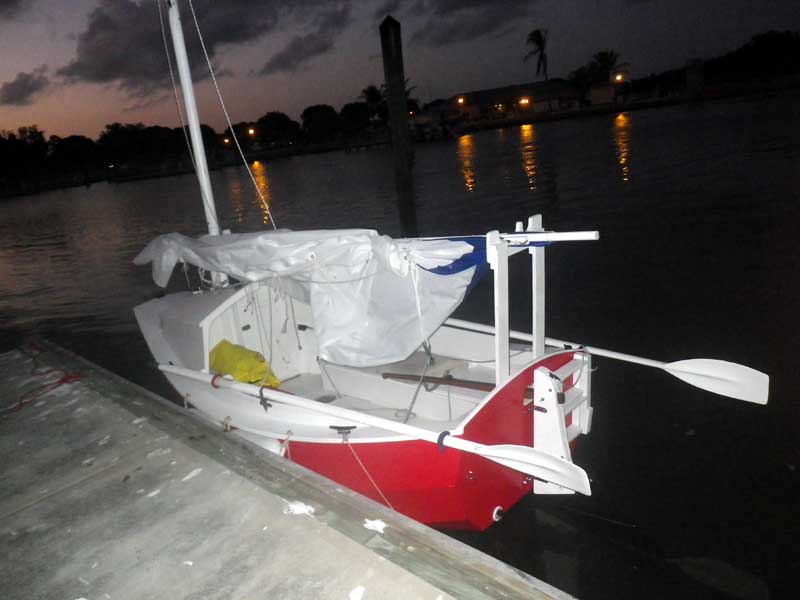
The misery didn’t stop when the sun came up. We still hadn’t weathered Cape Sable and entered Florida Bay – the wind and waves were such that it took us over a dozen tacks, sometimes gaining only 500 feet or so per hour long tack, before we finally entered the bay. Even then, it got worse – once we were in the bay we were no longer protected by land and suffered the full force of the wind and the waves grew from two feet to three feet, with the occasional four footer thrown in, just for fun.
The wind was from the east, again, right from where we wanted to be. It took us all day to cover the 12 or so miles from Cape Sable to Flamingo. I was scared, pissed, and tired, but the end was in sight.
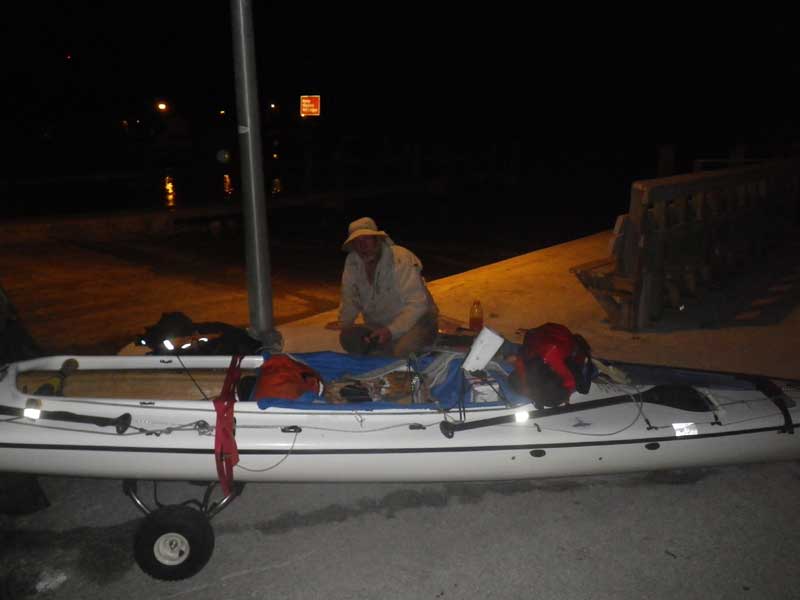
Flamingo is a good place for a checkpoint: Bathrooms and showers and all kinds of space to lie down and sleep. Whitecaps (Toby Nipper) was getting his gear ready for a final push.
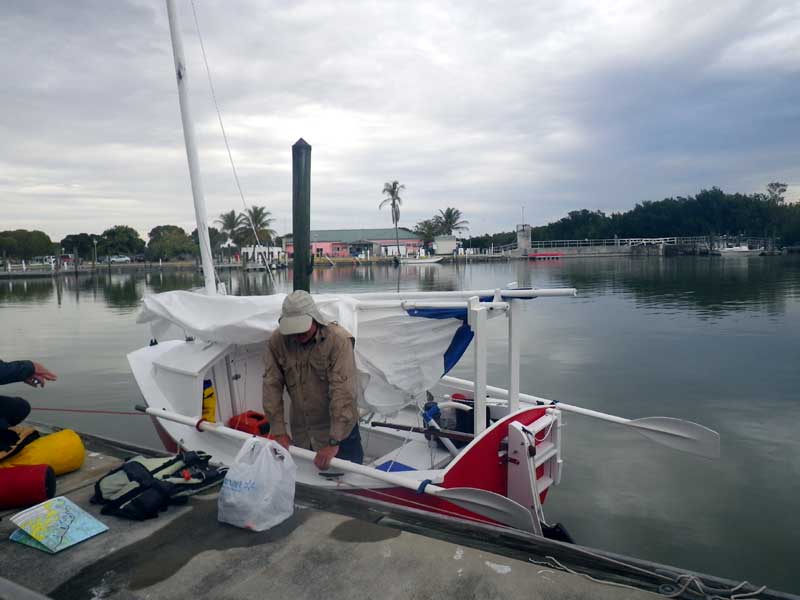
We decided to wait it out until Thursday evening when the winds were expected to come from the north. With a north wind, we could take the much shorter (and more difficult to navigate) upper passage through Dump Keys and Crocodile Drag. We spent the day re-provisioning and planning.
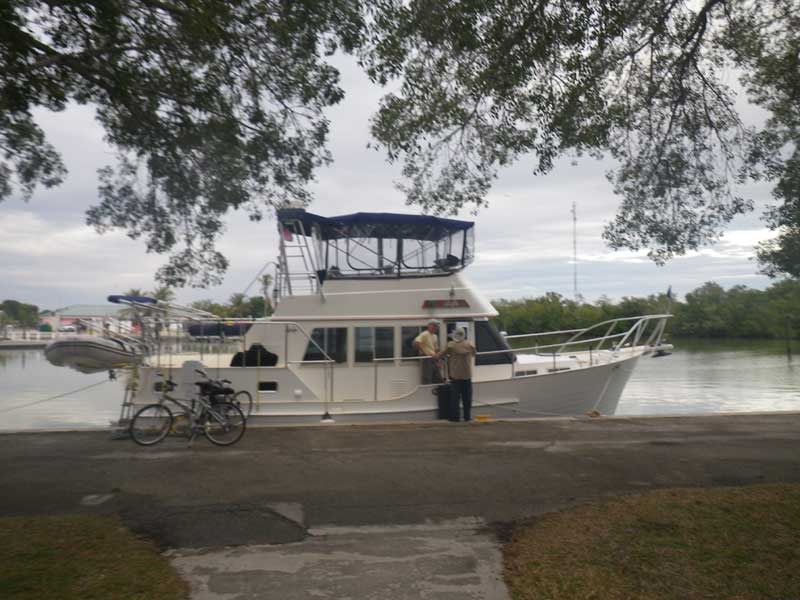
We borrowed a pair of channel locks from the couple on this live-aboard. They'd seen us traverse the bay the day before and were mightily impressed with both our sailing and our tough little boat.
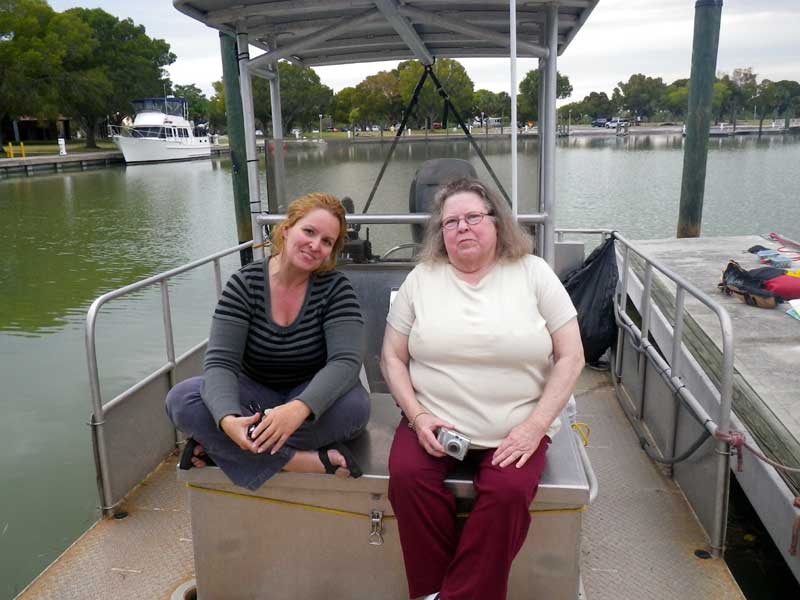
Sometime in the late afternoon, Jackie came along with a young woman in tow. The newcomer is a Watertriber named Whirlwind, but more commonly known as Esther. She is starting a kayak company called Paddle House.
Esther turned out to be quite a find. She made adjustments to my camera (probably not needed) took over and “fixed” our primary flashlight (probably needed) and gave us some advice (very much needed.) She would come into play later, as well.
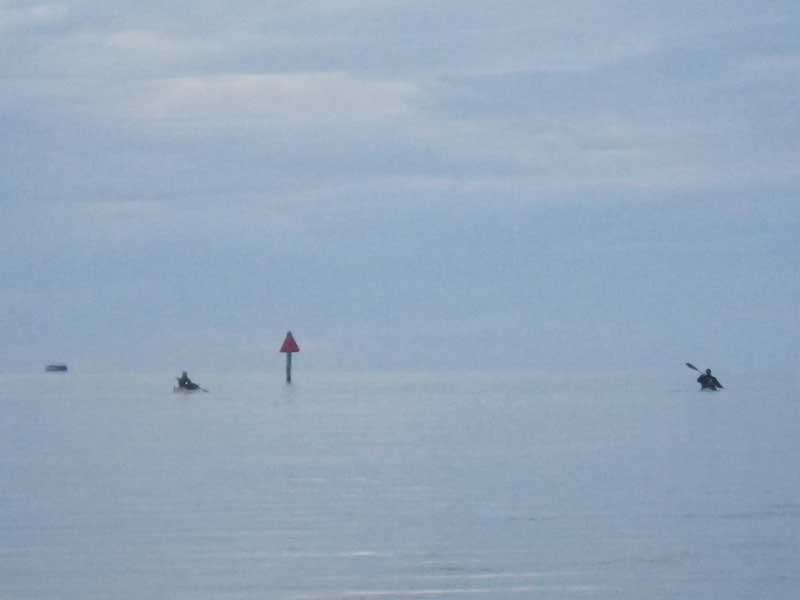
Our plan was to sail out in the evening and anchor off Joe Kemp Key so we would be advantageously positioned for sailing as early as possible the next morning. We followed Kiwibird and Sieche (Kristen Greenaway and Denny Thorley) out the channel.
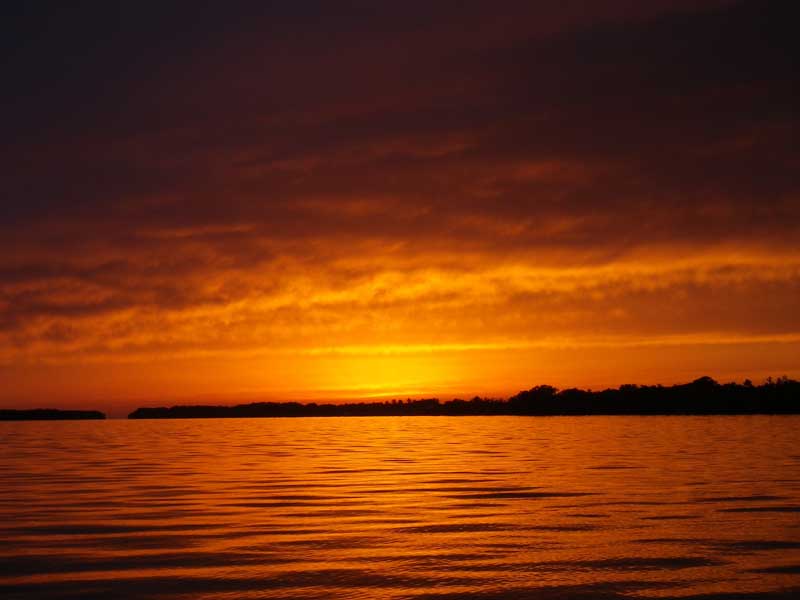
As evening fell, we were securely anchored off Joe Kemp Key and ready for the short, sweet trip to Key Largo and everlasting fame. Was I delighted with this sunset? Yes Yes, I was.
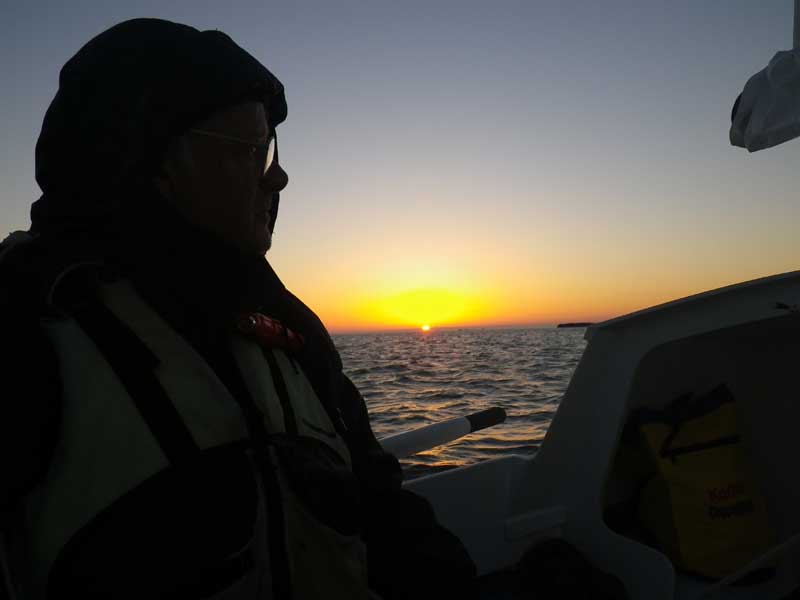
We were up at the crack of dawn and seeking a marker where three channels branched out – one to the northeast (Joe Kemp Channel,) one to the east (Tin Can Pass,) and one to the south (East Foy Channel.) We wanted Tin Can, the one to the east.
The wind had blown from the north all night – we were set up for a perfect run to Key Largo.
I had the spot in my GPS, but we kept looking for markers. What we thought were markers were actually wading birds. We found a channel (East Foy) and started following it, and it wasn’t until too late we discovered we were going south instead of east.
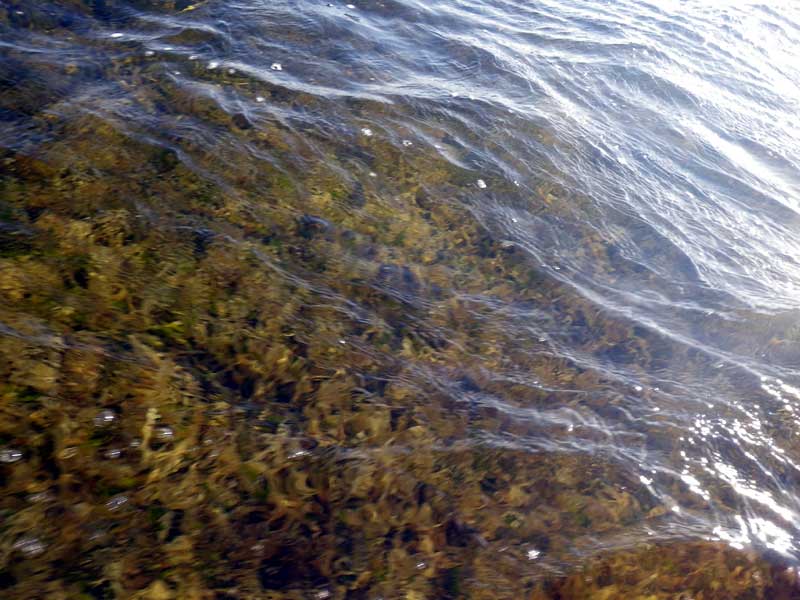
By the time I realized our error, we were quite a ways down the East Foy channel. To get back on track, we needed to cut across some open space between Cormorant and Cerlew keys. The charts and GPS showed an average water depth of 1 to 2 feet, so I thought we wouldn’t have any problems (a SCAMP draws about 7 inches.)
What I hadn’t counted on was the wind – the strong north wind was blowing the water out of the bay.
As we came behind Cormorant Key, the water started to get very shallow. This is what water looks like when you suck at navigation.
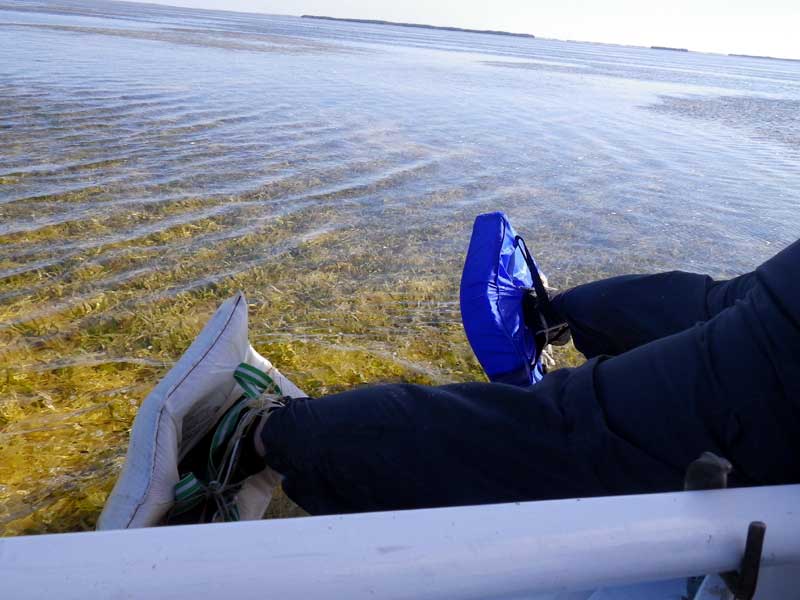
Eventually, we ran agound and got stuck. The mud is far too soft to stand on, so I tied floats to my feet, hopped over the side, and started pushing while Mike worked the sails.
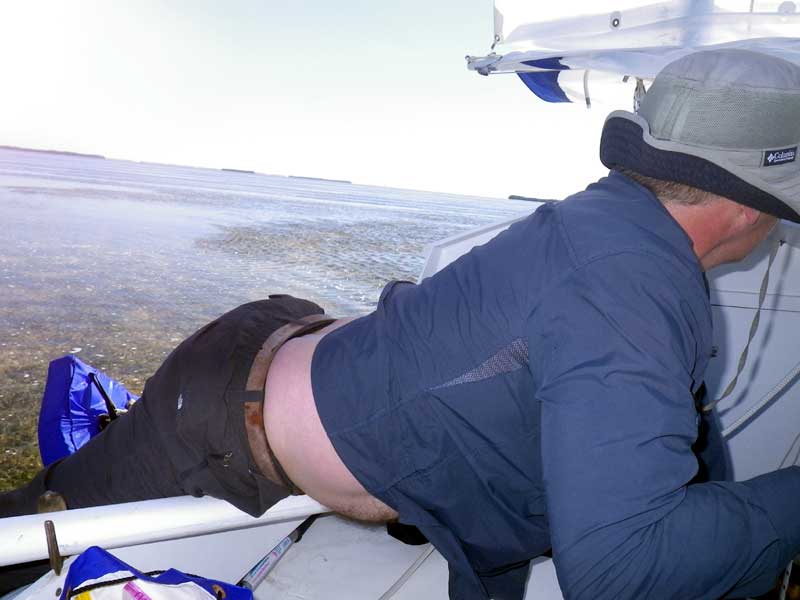
We worked the boat hard for another hour or so. If I wasn’t out, pushing, I was hanging on for dear life as the boat tried to sail away. Sometimes, I'd hit the sweeps and drive the boat on through sheer effort (Mike working the sails, of course.)
This was exhausting, miserable work. In the end, all we did was drive us deeper and deeper into the shallows.
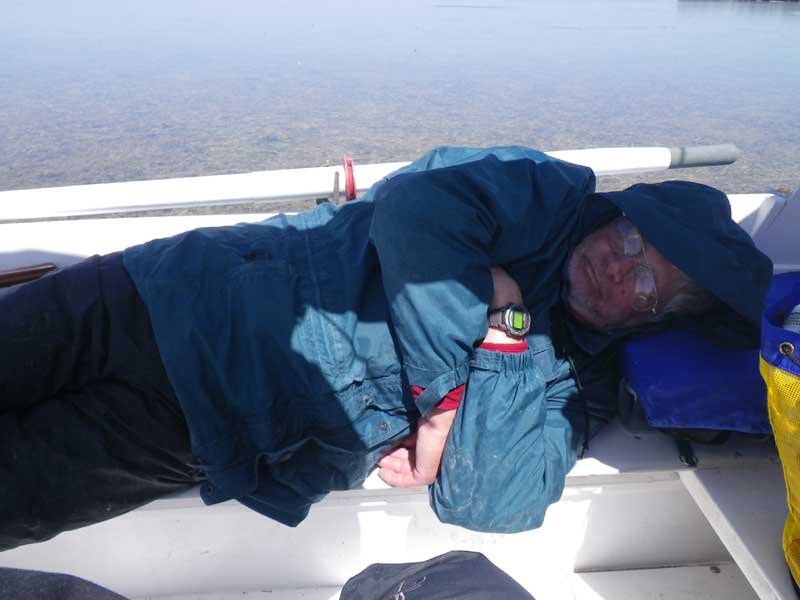
Eventually, we could move no more. There was nothing to do but wait for the tide.
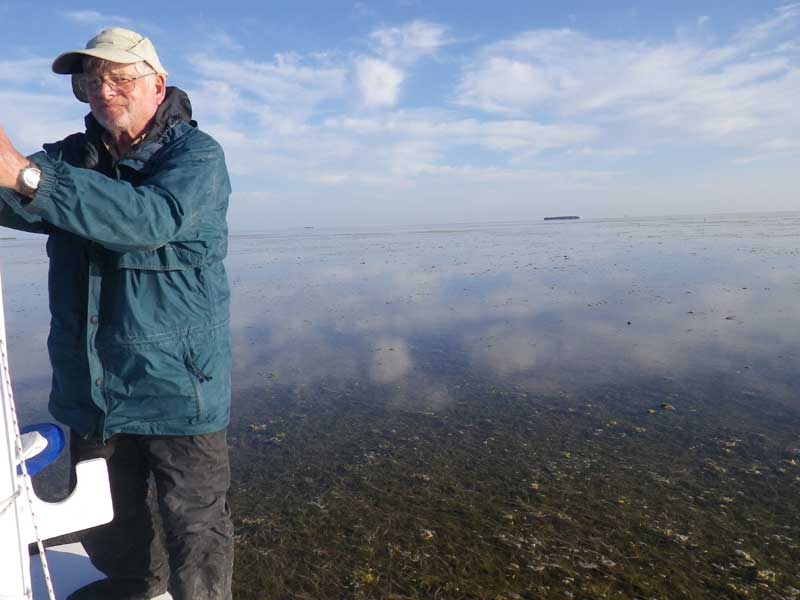
See all that seagrass floating on the surface? That wasn’t there when we tried to cross this patch of water. Now it was nothing but seagrass from horizon to horizon. (nice picture, though)
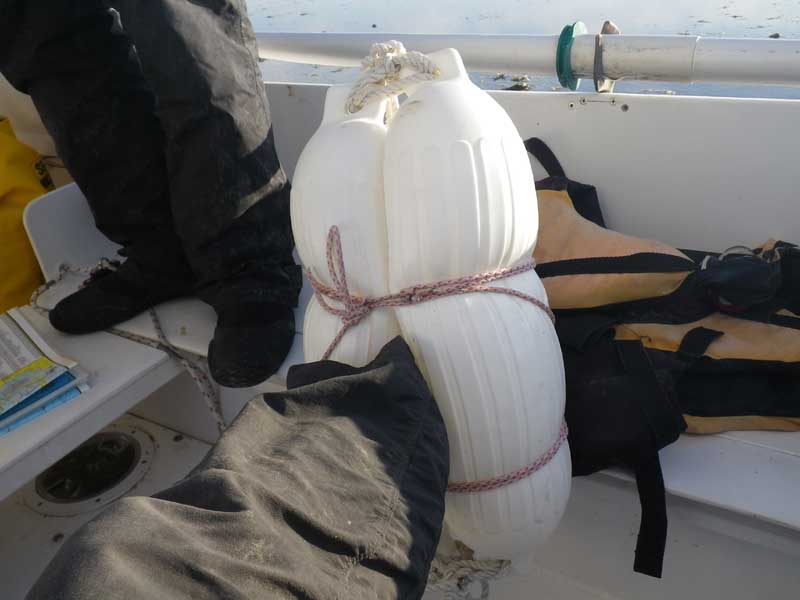
The float cushions weren’t the best for mud shoes. Without shoes, I'd sink well over my thigh. Even with mud shoes, I'd sink. I tried it once without shoes and sunk up to my crotch with almost no resistance.
This time, I tried tying boat fenders to my feet. This held me up better – and fought the suction better – than float cushions, but no matter how tight I tied them, the fenders would slide up and down my leg a little, grinding shells and muck into my lower calf.
I hit upon the best configuration on my next attempt: Tie the floats together, then tie my feet on top of them (standing on the line wrapped around the fenders.) Again - not perfect as I was more tippy and the fenders tended to turn sideways, but it was the best configuration I could come up with.
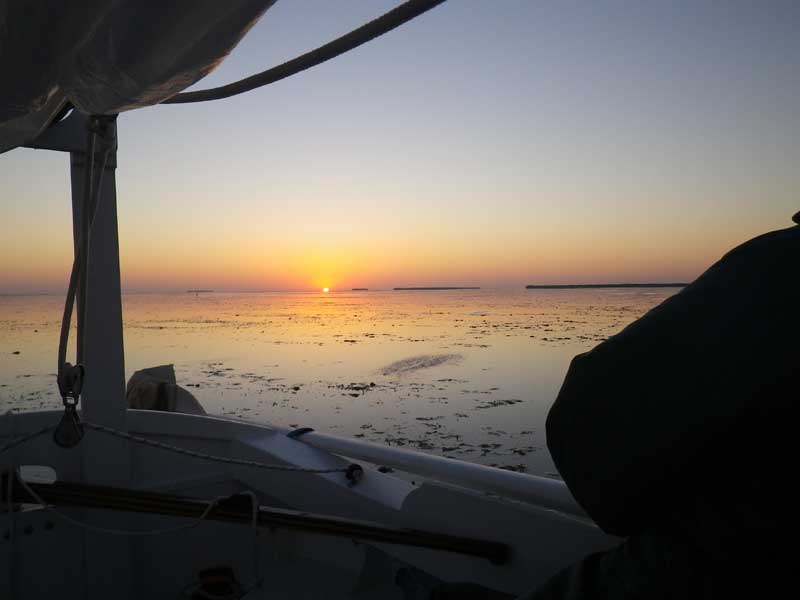
Dusk came with no change in the water levels. This was our second consecutive night on the boat.
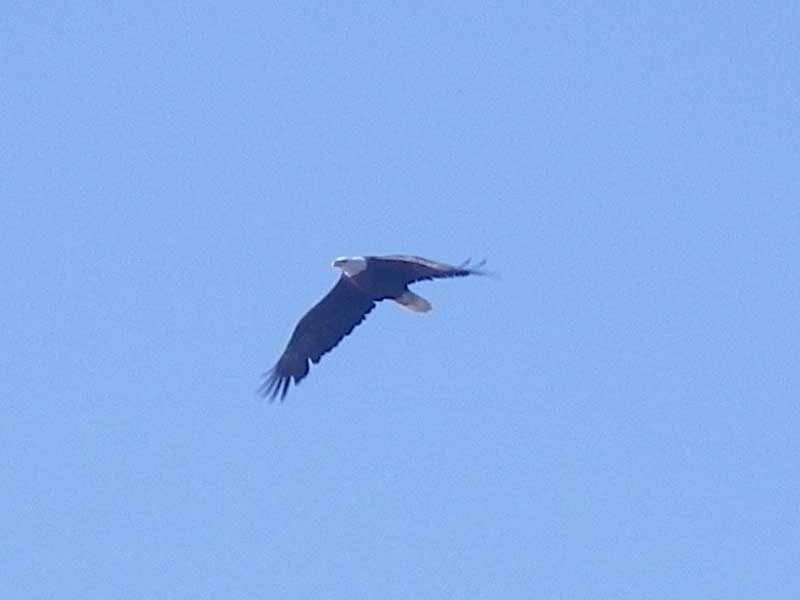
Sun went down, sun came up. No change. We called the rangers and asked what our options were. They said they were going to send someone out to assess the situation.
We were within about 50 yards of Cerlew Key and watched the eagles fly around for a while. Too bored to do nothing, we battled the boat to the east side of Cerlew Key to see if the water was any better over there.
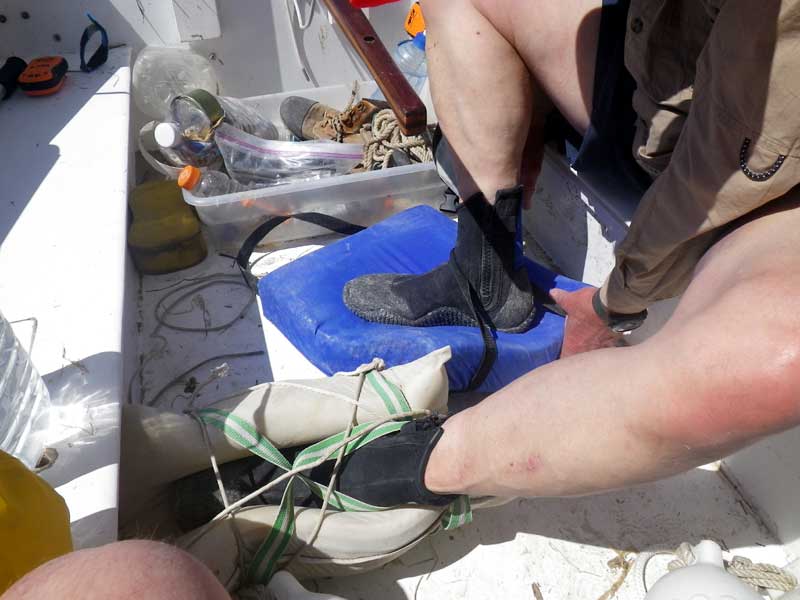
Just me out and pushing wasn’t enough, so Mike started wearing the shoes, too. With both of us out and pushing, it was REALLY dangerous – of the boat got away, we were screwed. We made it to the other side of Cerlew Key and sat there.
A fishing guide came by “because he thought we needed help” but I suspect he was trying to get his customers into restricted areas. He offered to take us off, but we declined, thinking the rangers were coming to the rescue.
A couple hours later, the rangers called us and said they were as close as they could get – about 2 miles away. They said (paraphrased): You are in a sensitive area. We can’t come in to get you out. No one can get you out except by helicopter, and only if you have a medical emergency. If you evacuate by helicopter, you cannot take any gear and your boat will be declared abandoned. Our best advice is for you to save yourself.
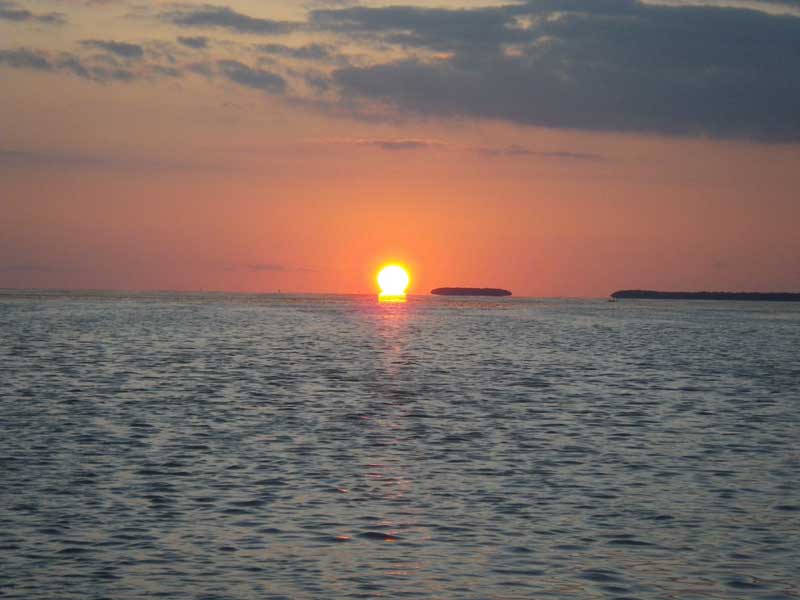
The tide was supposed to come in. As I looked at my tide charts, it looked like we were supposed to have a couple feet of water. Mike looked over and said “Those lines don’t show feet of change. They show inches of change.”
WTF? Who has a tide of inches?
Oh yeah, that crap about a ‘green flash”? That’s a lie. I watched enough sunsets on this trip to state that with authority.

Sun went down. Sun came up. No change.
With nothing better to do, we fought the boat back to the other side of the island again. If anyone is wondering why we didn’t just go hang out on the island: Because every square inch was covered with impenetrable mangrove.
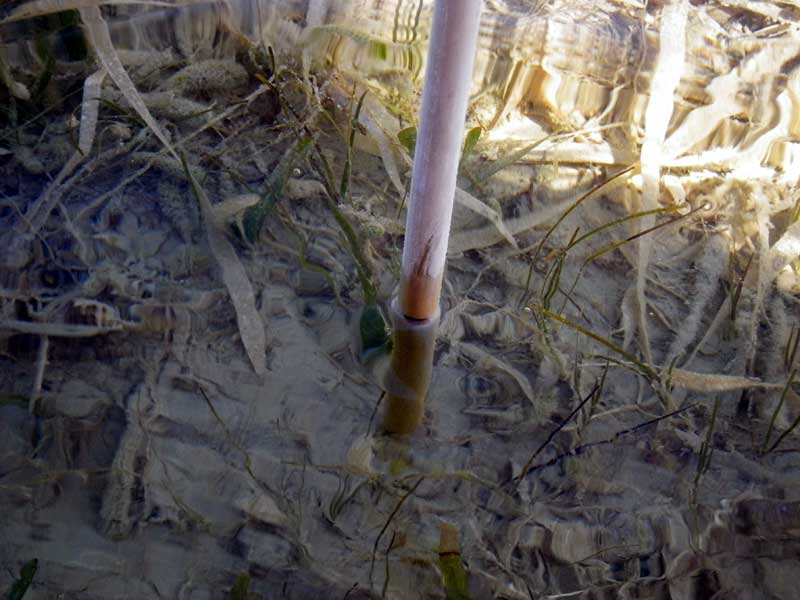
I could not believe there was no tide, so I pushed this stick into the muck 1/8” was all it changed – all frigging day.
With nothing but time on my hands, I started doing some math. Mike weighs about 150lbs. I weigh about 200. We had about 120lbs of gear, food and water. I figured for every 200lbs we could get off the boat, she'd rise up about 1”. We figured we were about a half mile from sailable water (just a wild guess.)
Tp illustrate just how stuck we were, when I got out of the boat, she still wouldn’t float free. She'd move with terrific effort (me pushing, Mike sailing and working the oars) but she wouldn’t sail.
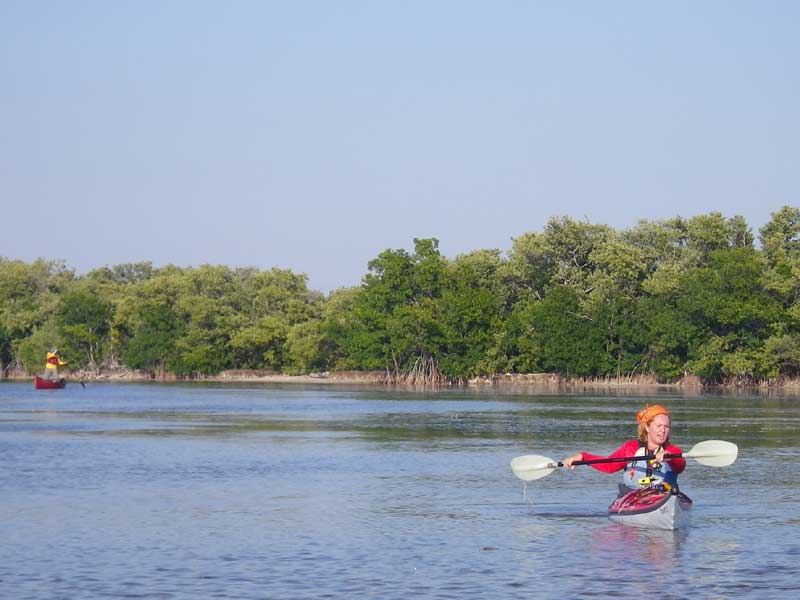
While Mike and I were slowly growing older waiting for water to return to the bay, Jackie had been at work behind the scenes, arranging for a rescue. Esther and her partner, Wayne, convinced the rangers to bring them as close as possible (about 2 miles) with a canoe and kayak. They then paddled over to us while we made ready for the extraction.
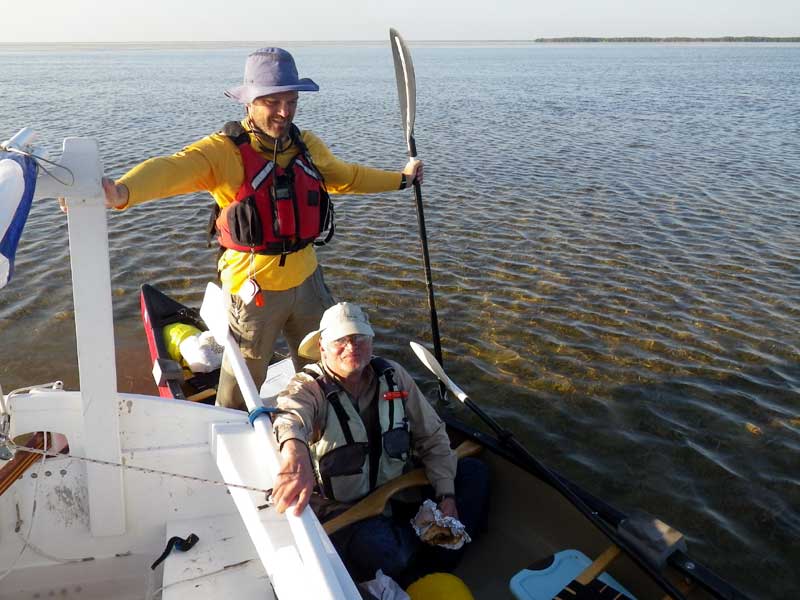
Our first plan was to just have me leave with as much gear as could be spared. Esther informed us that the winds were going to stay from the north or northeast and the tides would stay low for at least week until the new moon. We decided both Mike and I would go, as well as everything except the gear Mike would need to sail her out later.
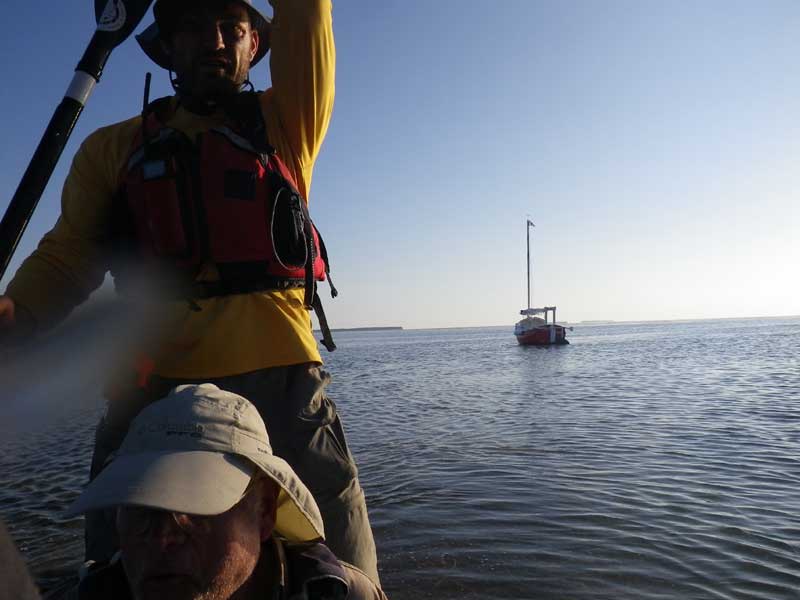
And there we go. I’ve built boats, sold boats, given boats away, and burned boats, but this is the first time I’ve ever abandoned a boat.
The ~2 mile paddle back to the ranger boat was one of the most physically demanding things I have done in a long time. Wayne is a heck of a paddle man, and he was in the front. Our boat was overloaded with the three of us, and we scraped bottom almost all the way. Both Wayne and I stood up and ‘poled’ through the mud as hard as we could, me doing my best to keep up while Wayne set the pace. Esther even tried tossing us a line and dragging – not that a kayak has very much towing capacity.
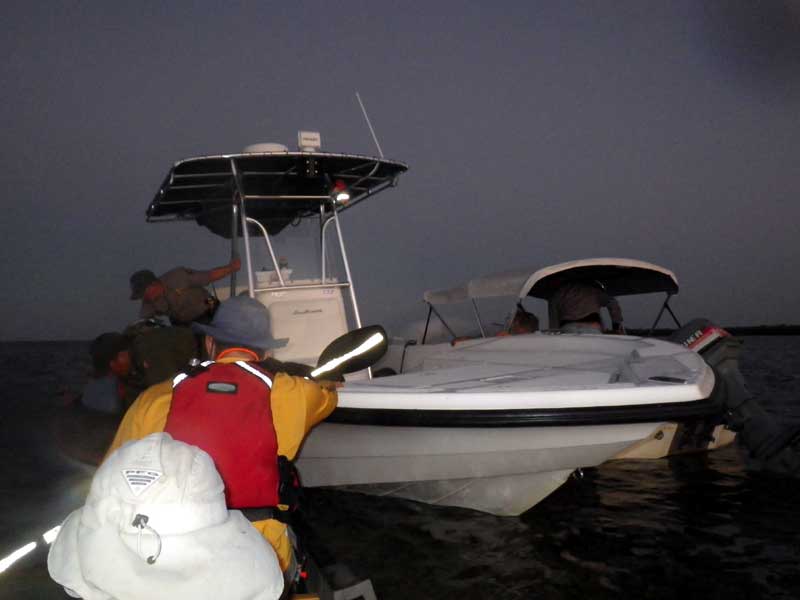
The ranger had said since we were being extracted by civilians and had informed the park service as to our intentions, we could secure the boat and they would not declare it abandoned. They'd call Mike and let him know when conditions would be right to return and retrieve the boat.
Officer Moore and Officer Mullet were very understanding and concerned for our well being and the well being of the park. They could have been . . . authoritarian about the situation, but I felt they were very professional and competent.
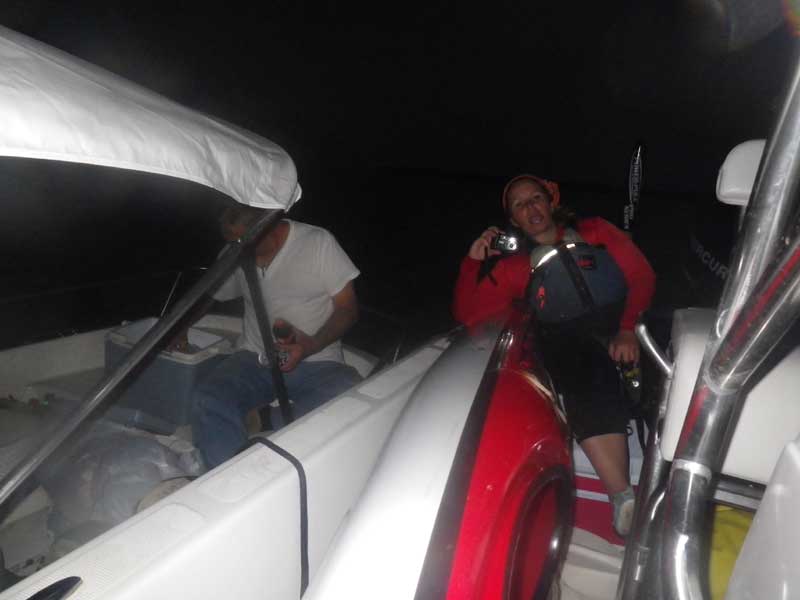
In an interesting twist, Lonnie Black of Tampa Bay had come down to Flamingo to help – arriving at about the same time as the rangers. Lonnie and one of his workers, Jose, drove the 200+ miles from Tampa, towing their Boston Whaler and an inflatable raft. They also brought food, water, and over 1000’ of towline. The rangers were not too happy with Lonnie’s unauthorized rescue attempt, but I was delighted to see an ordinary citizen go to extraordinary effort to help people he'd barely heard of.
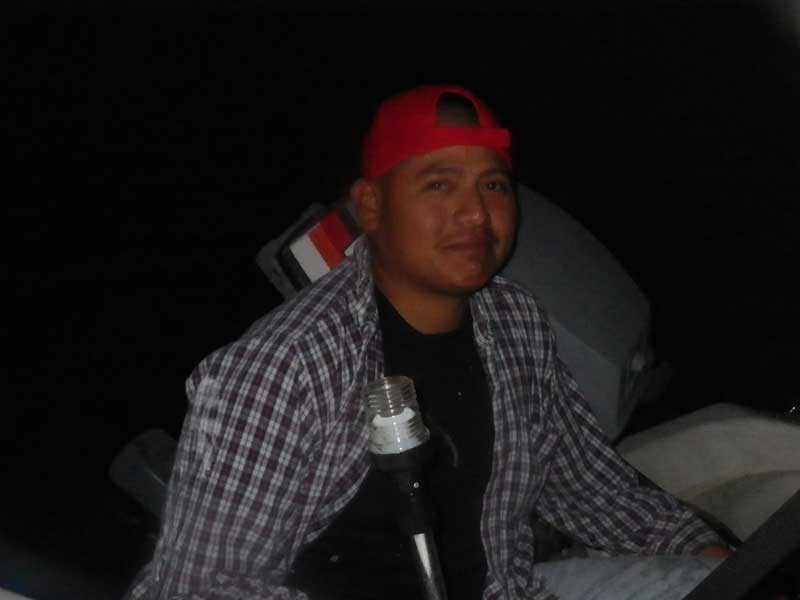
I asked Jose why he'd come along on this trip – a minimum of 10 hours round trip on the highway and however long in the boats. He replied, “It looked like fun.” Yer a good man, Jose. I appreciate everything you did.
Real life rarely plays out like the movies. The rangers loaded Esther, Wayne, Mike and I, and Esther’s kayak and canoe, on their boat and . . . got stuck in the mud themselves. To lighten the load, I got into Lonnie’s boat and we all made our way out into the channel. I transferred back to the ranger boat and we began the tripo back.
About halfway through the run back to Flamingo, Lonnie’s boat suffered an engine malfunction and drifted out of the channel and into the mud. The rangers took us on to Flamingo, told us to stay put, and went back out for Lonnie.
All in a night’s work, I guess.
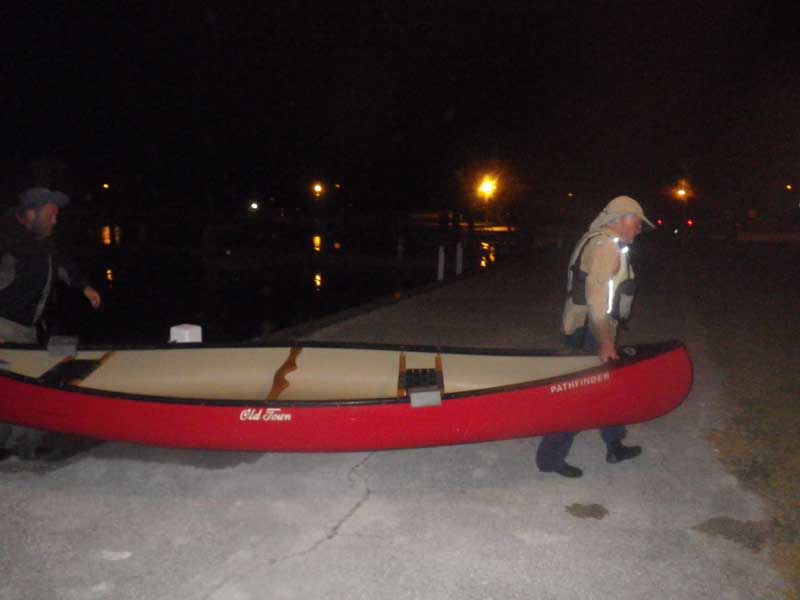
At Flamingo, we unloaded the ranger boat, and hung around, making phone calls and arranging gear while the rangers went back for Lonnie and Jose. When they retuned, Officer Moore explained to us the difficulties we had caused and admonished us to conduct ourselves more competently in the future.
Jackie and Pauline (and Dickens the Adventure Hound) picked us up and we spent the night in Florida City, before making our way to the Tampa Bay airport on Monday. I flew home, leaving Mike, Jackie, and their new-found friends to figure out the logistics of getting Mike back on the boat and the boat out of the mud.
On March 19, the moon will be full and will be as close to the earth as it has been in 18 years (this has been dubed a ‘supermoon’ by popular media) bringing the possibilities of higher than normal tides for Florida Bay. The winds are from the east, which is not perfect, but it is better than winds from the north.
The last I have heard is that the rangers allowed Mike to hire a fisherman to drop him off near the boat, and that “Mike crawled ½ mile to the boat on his hands and knees” on Friday the 18th. His cell phone gave out during the crawl, and there has been no further contact.